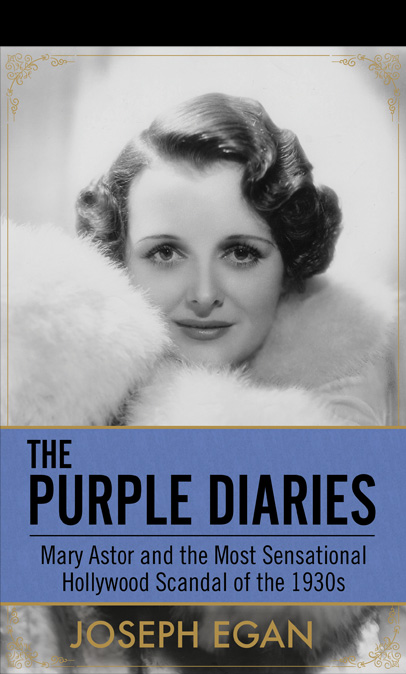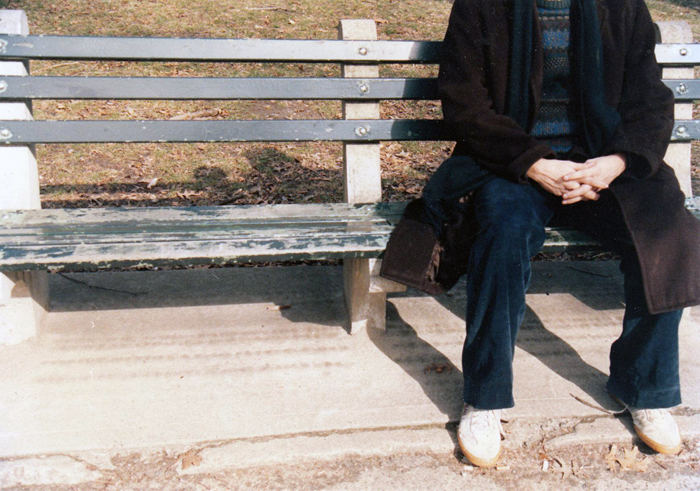

PORTRAIT OF EDWARD SOREL AT WORK BY STEPHAN ALCOVE
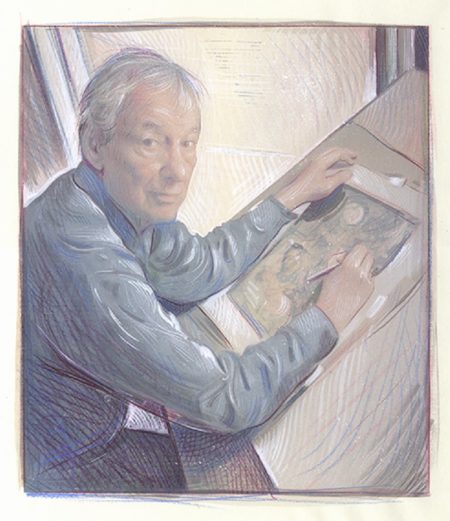
Edward Sorel, the award winning caricaturist has also written a book about the 1936 Mary Astor Custody Battle—Mary Astor’s Purple Diary. I am fortunate in having just read an advance review copy and can tell you that Mr. Sorel has illustrated and written a hilarious look of a mass media circus before television, 24-hour Cable news, the IPad, IPhone, Facebook and even Twitter. It is a journey back in time that will seem utterly pre-historic to the millennial generation but no less fascinating. Mr. Sorel chose to write and illustrate a book that makes light not so much on the participants but, instead, the Media which, like a ravenous pack of wolves, fed on a scandal of their own making turning these events—in the newspapers at least—into a farce of the first order. In time it became a story where legend would sublimate fact. It is this legend that Mr. Sorel writes about in his delightfully humorous book. Below are some illustrations from the book with a brief description of how the book came to be written. This material appeared on The New Yorker and Vanity Fair Websites. As I didn’t ask their permission to use it here, if the publications want me to remove it, just write me and I will do as requested but don’t expect me to do it right away. I’ll need some really threatening letters first. If they allow them to stay I will be eternally grateful.
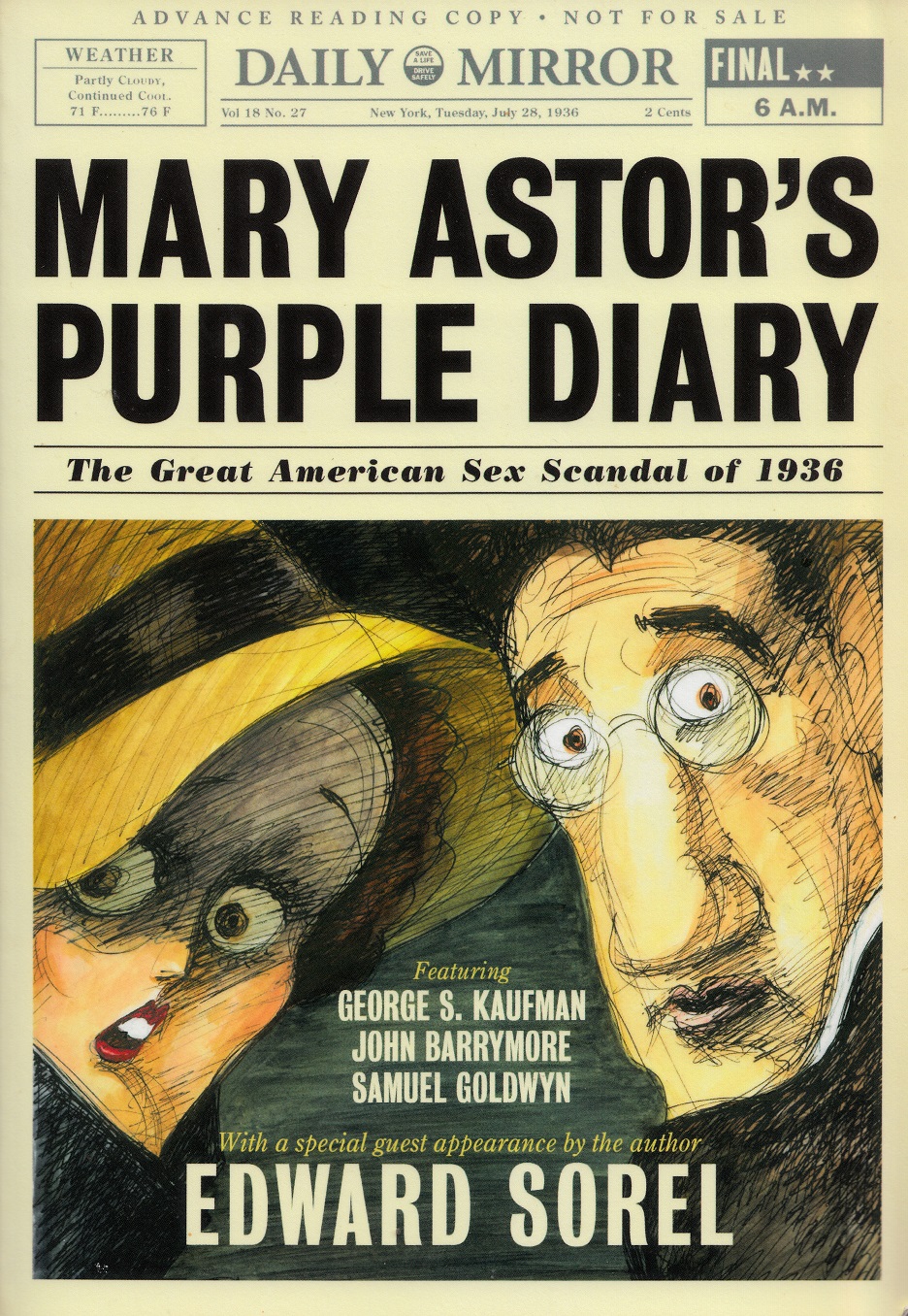
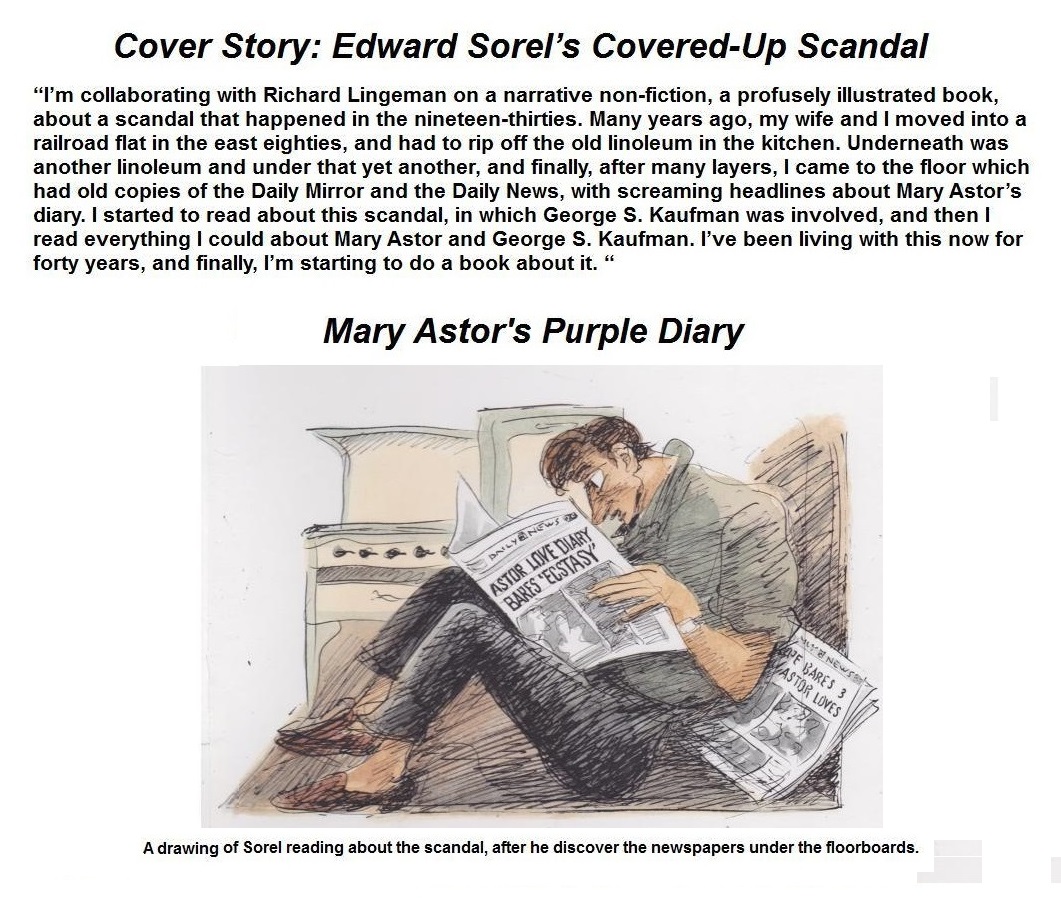

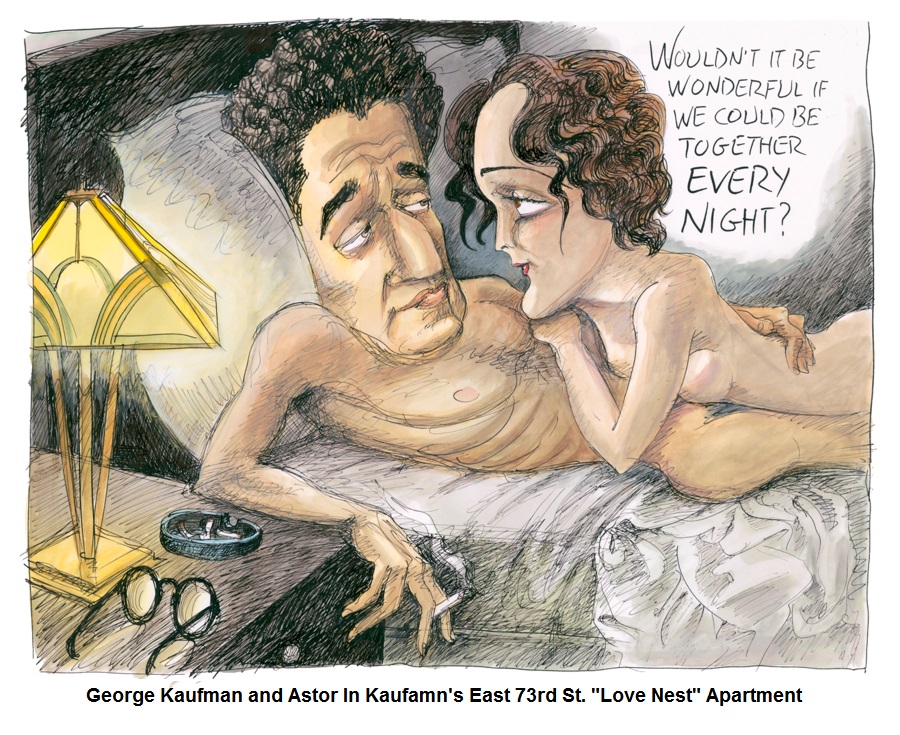
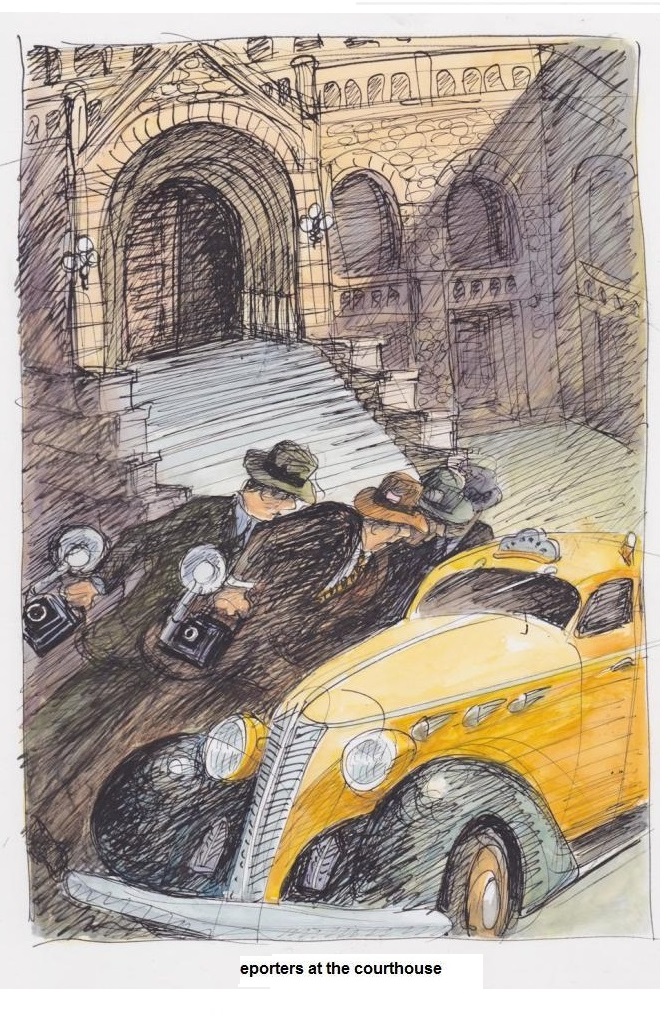
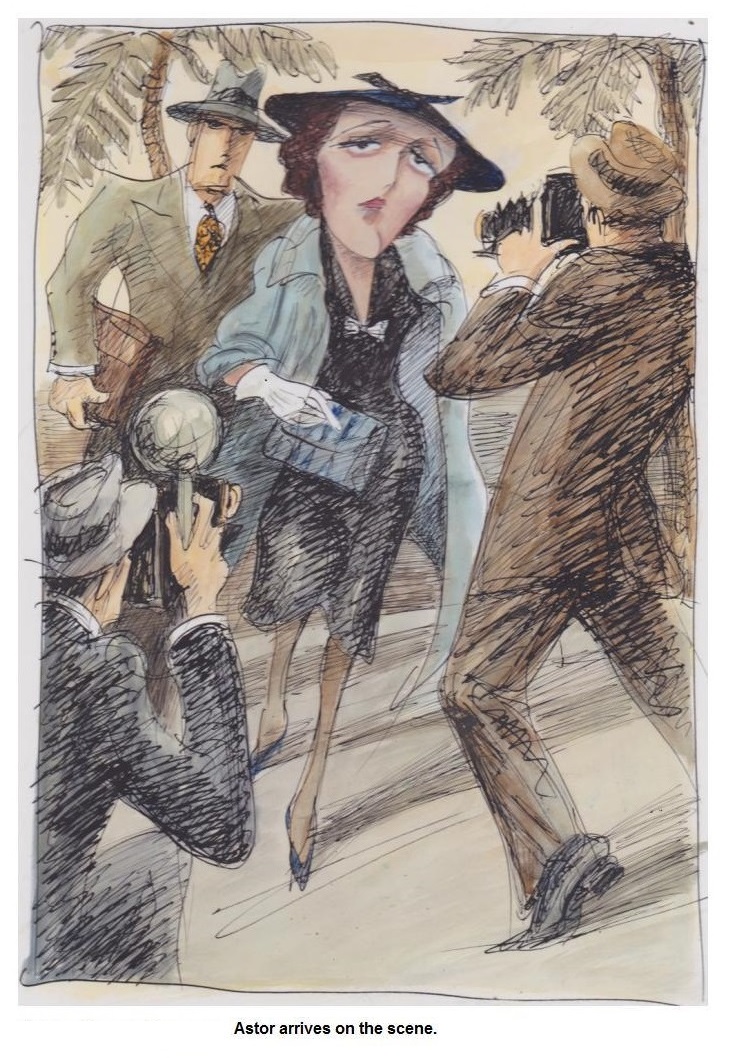
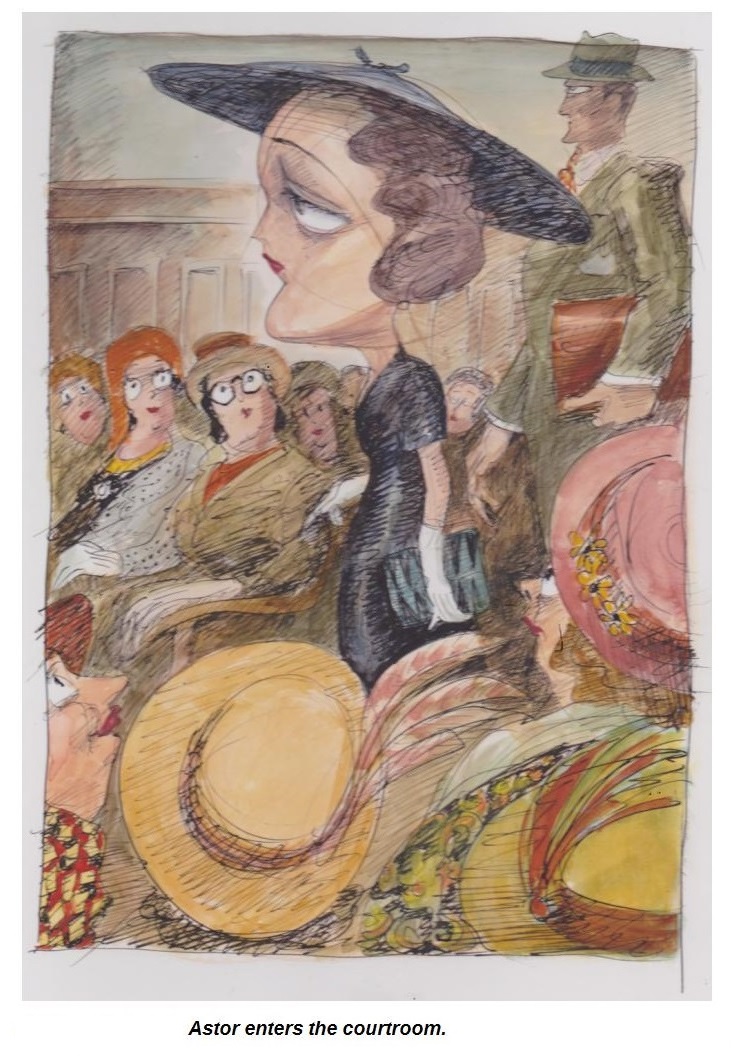

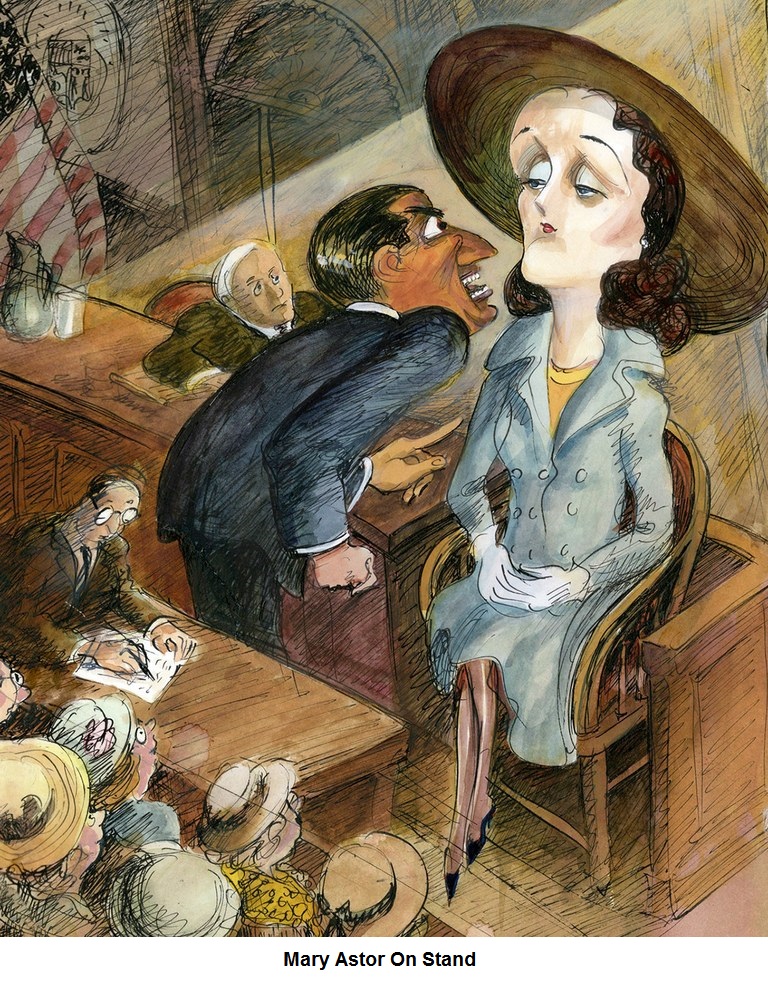
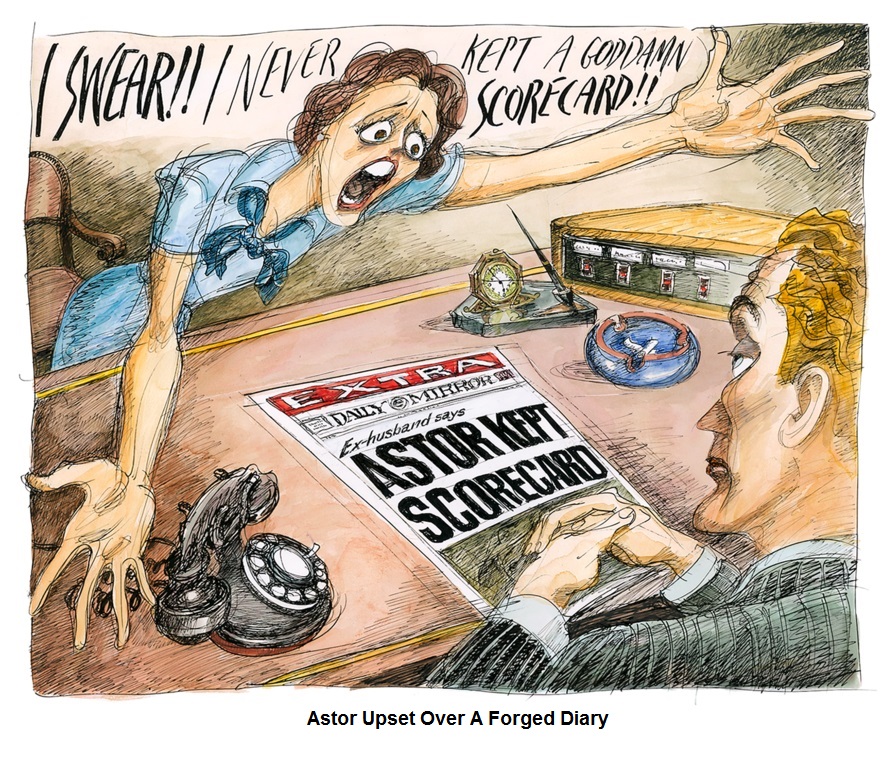
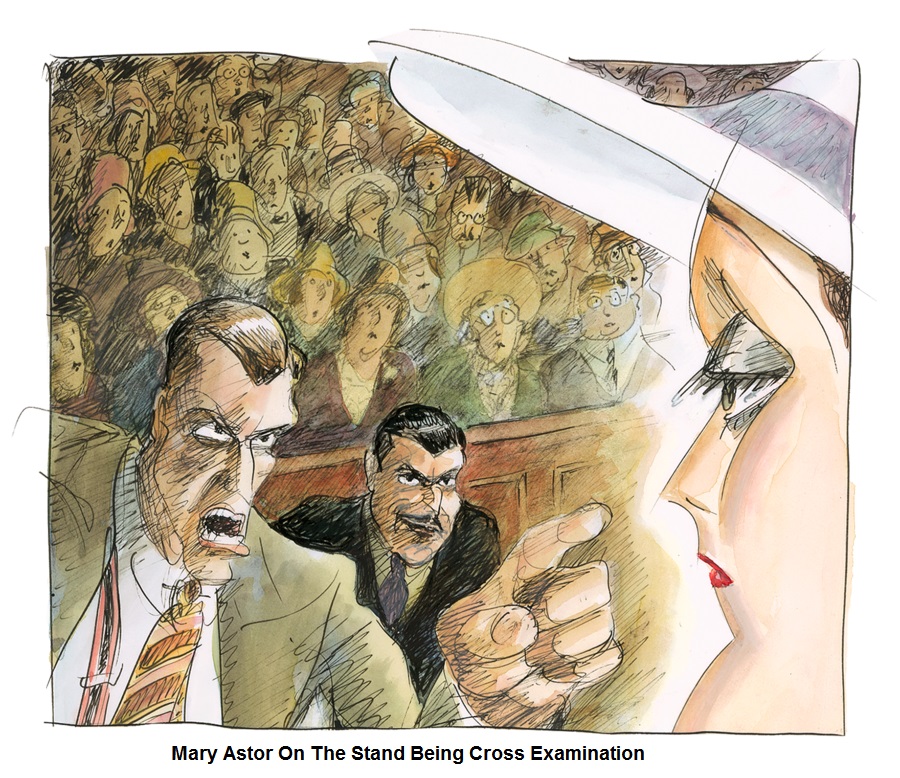
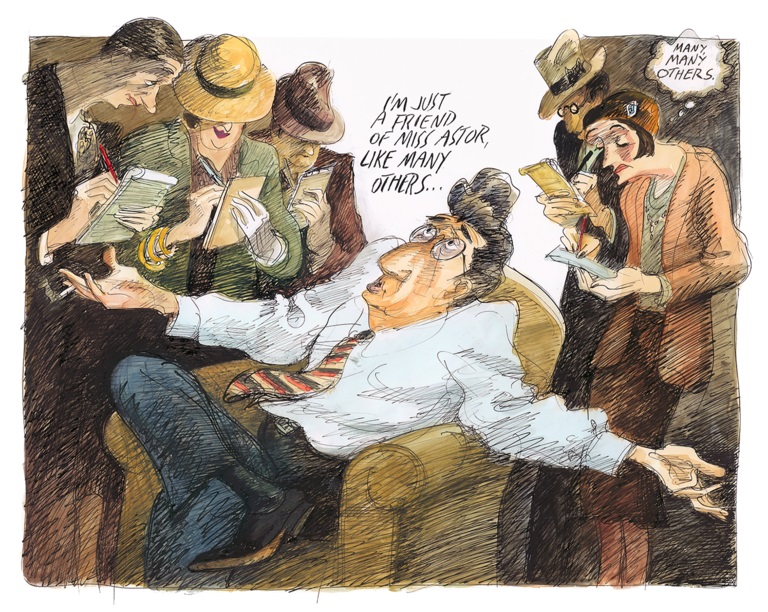
My wife loves the book, calls the writing sweet and gentle and thinks the sections in which Mr. Sorel writes about his own life among the best passages in the book. I agree. I have read the book three times chucking and laughing more each time I read it. Because I am as familiar with the subject as I am (My own book which provides a serious look at these events comes out in November), I was able to fully appreciate what Mr. Sorel has accomplished. I will not allow my copy of his book out my house nor will I lend it to anyone and that even includes my children.
Our two books are very, very different. A friend put it best when he wrote me, “Edward clearly loves Astor in the way that you do as a fan who wants to see her story told in the medium he best knows how to tell it. You in a work of non-fiction and Edward in an illustrated interpretation of a mythic event. His reads like a wistful memoir, almost dreamlike, and yours feels ‘hot off the presses’, and very now.”
I couldn’t put it better myself. Each book is a completely different experience. In fact, they are so different that, when I read his book, it really surprised me how different they were and Edward Sorel felt the same. His book is a highly personal and very subjective look at the scandal as well as Mary Astor in which he writes about his own life—ups in downs—in a warm and gentle way that is Ed Sorel. What is interesting is that both of us became obsessed with subject; me for 20 years and Sorel for 50 and the two books are being published only weeks apart on the 80th anniversary of the trial. I think that’s called serendipity. Because I worked with the family and did exhaustive research, my book is more a look from the inside of the story outward. Sorel’s is more about how someone from the outside would see it—having gotten most of their information from the media—looking in. Put them together and you will be reading the whole story—the truth—and the myth and legend that grew out of that truth. But, no matter how it is told, the Mary Astor Custody Battle is a fascinating story.
Regarding the Edward Sorel’s Purple Diary title and my Purple Diaries title; remember, Sorel’s book is more about the press and a reflection of contemporary reporting than mine. In short, The press reported this incorrectly. The diaries were contained in two, green, red-cornered ledger books. The first volume had entries from September, 1928 thru January 5, 1930 while the second had entries from March 25, 1930 through March 1935. But it was pages from the second volume—in which Astor discussed her relationship with George Kaufman—that were removed and brought into court for Astor to identify. Although the full diary, and what was finally given to the court, was contained in two volumes the press mistakenly reported that it was a single diary. That label stuck and the reason for the confusion.
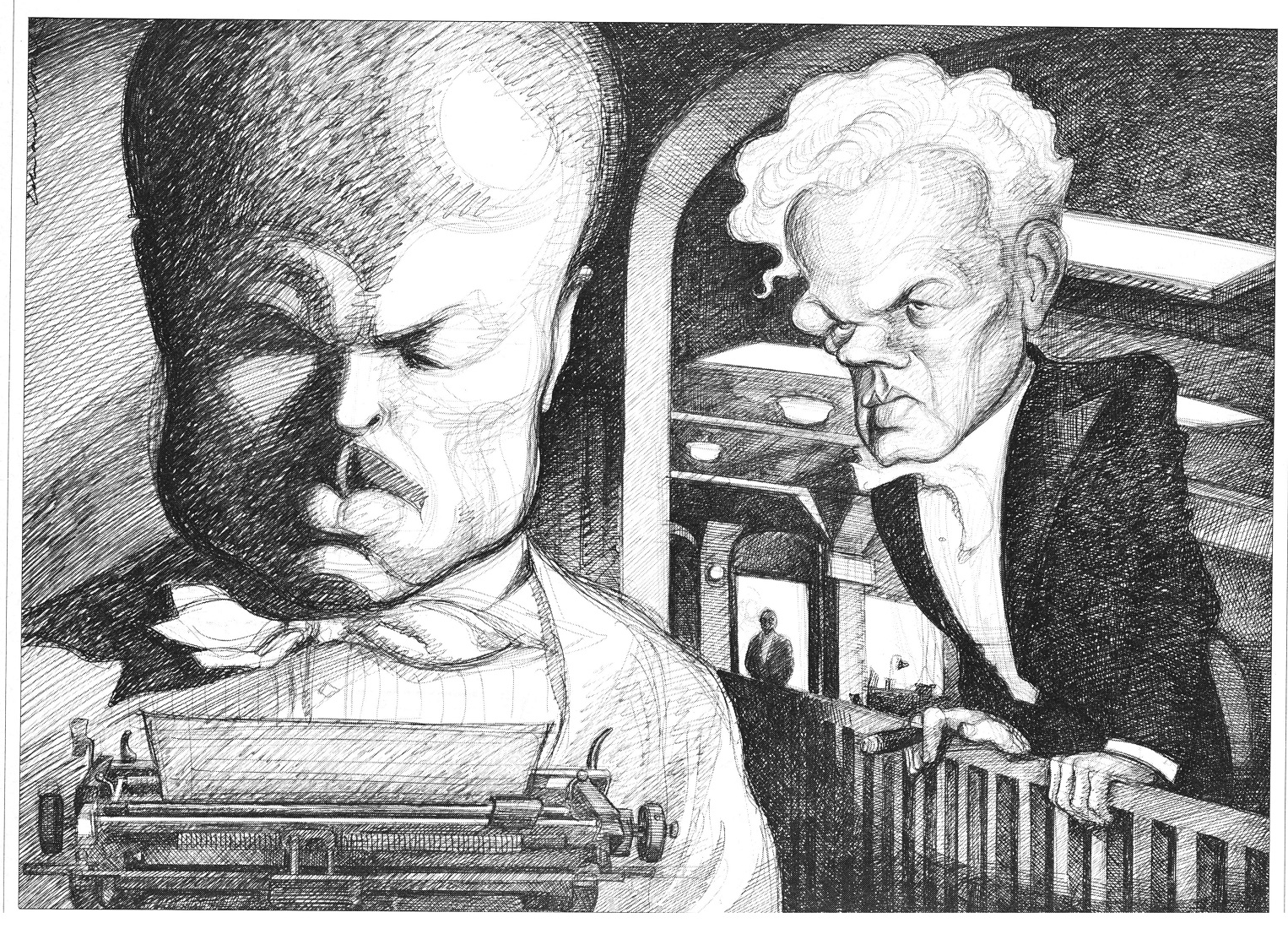
When I learned about the Sorel book it was just about the time that I was working with my editor on my book and I was simply ecstatic. I have been a fan of Mr. Sorel’s work—his covers have been on everything from Time Magazine to The Atlantic monthly—since the 80s when I fell head over heels in love with his series of brilliant film caricatures for Esquire Magazine, my favorite being his take on Citizen Kane above. Prior to Sorel my favorite caricaturists had been Hirschfield and Steadman. Hirschfield because his work was on the cover of the N.Y. Sunday Times Entertainment section when I was growing up and like everyone else, I counted the Nina’s in his drawings. With Steadman it was because his work became popular just about the time I was in college and heavy into acid—LSD for the uninitiated. Under the influence of that mind altering and enlightening drug Mr. Steadman was not only a ‘heavy,’ but made perfect sense. He still does, but not in quite the same way. But with Sorel it was different. There were no Nina’s to count and my LSD days are long behind me as I am now on a “reality” trip—meaning there is a point with LSD that it was no longer about enlightenment but, instead, being at that at the mercy of 12 hours of schizophrenia. Sorel’s drawings contain the visual ‘logic’ of dreams. His work is about how the subconscious sees the inconsistencies and absurdly of life and not merely how the eye sees it and, as such, his work reveals far greater truths. Below are some of his film caricatures including work that appeared Esquire. The films are The Maltese Falcon, The Godfather and Stage Coach. M, Jack Warner And His Tough Guys, Woody and Mia and Casablanca. Like Citizen Kane some of these are copyrighted by Esquire Magazine 1980, 1981 and if they want me to remove all they need do is ask. But I won’t do it right away and will need to receive several extremely threating letters. If they allow them to remain, I will once again be eternally grateful.
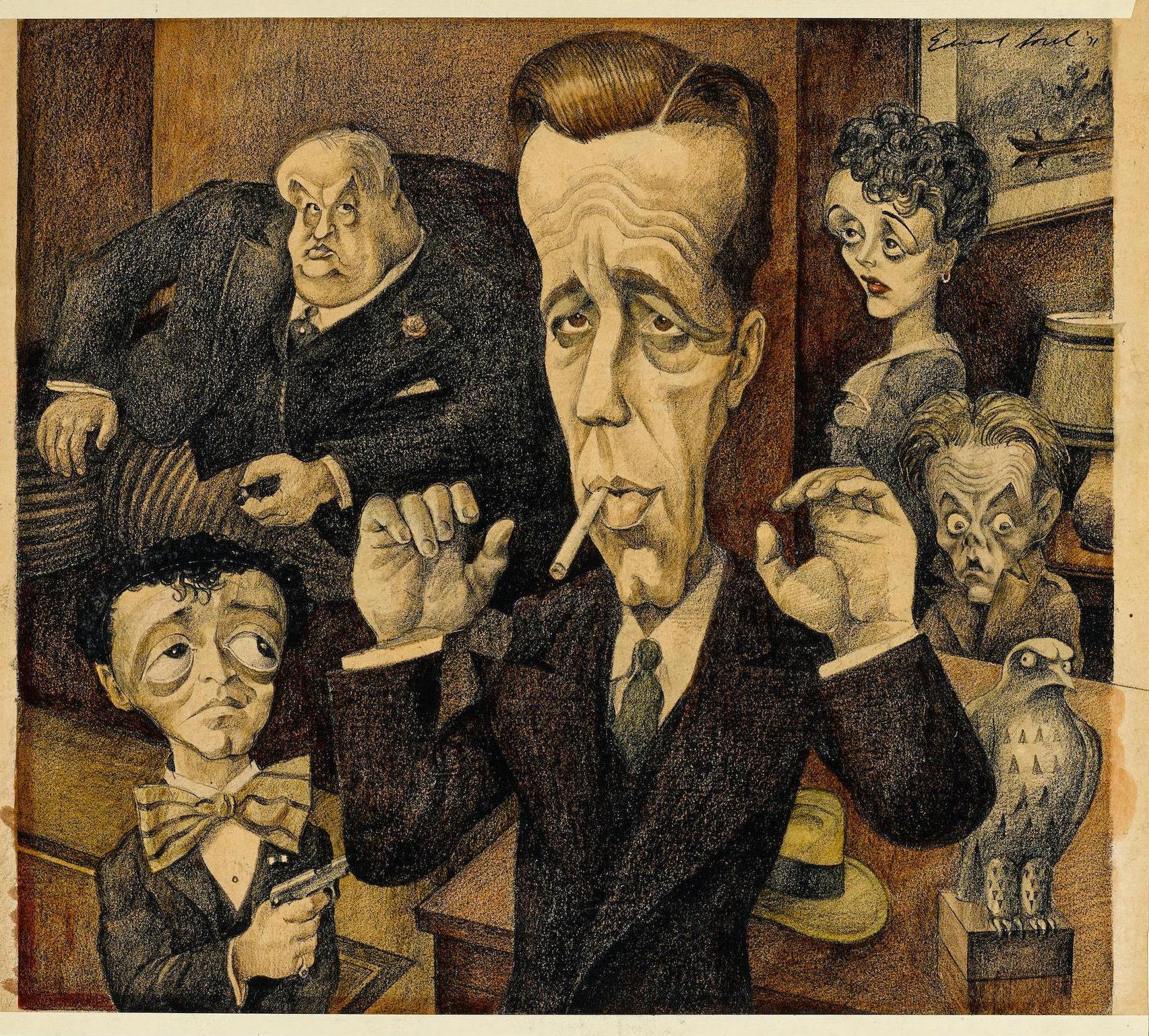


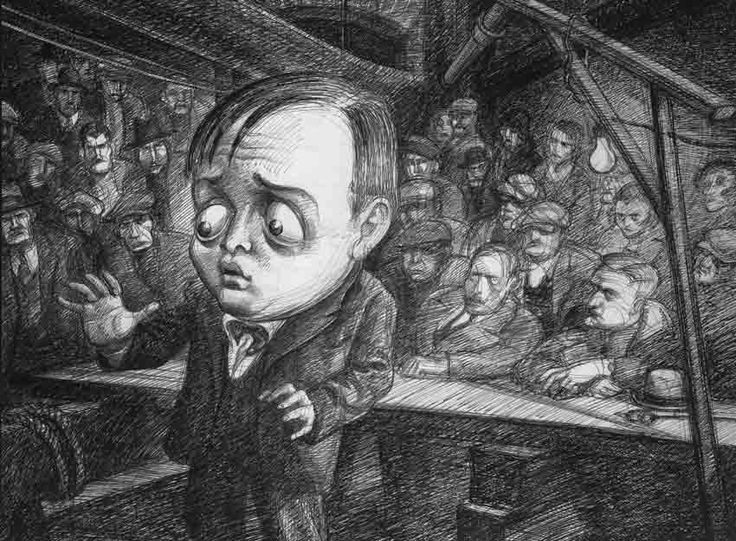
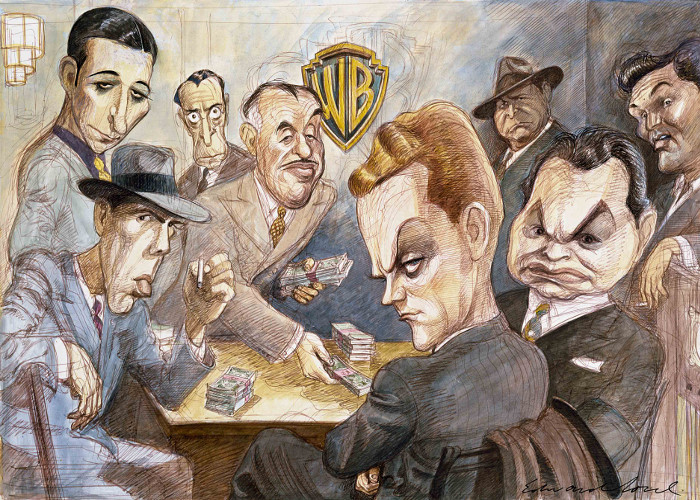
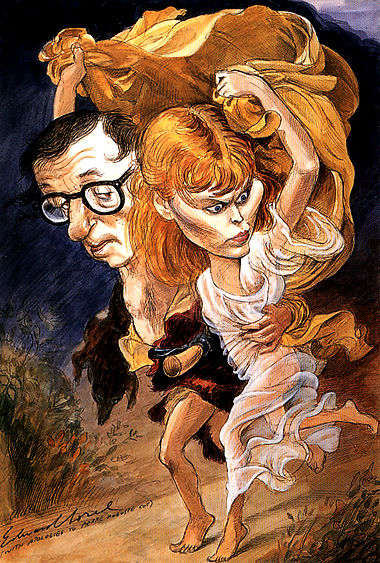
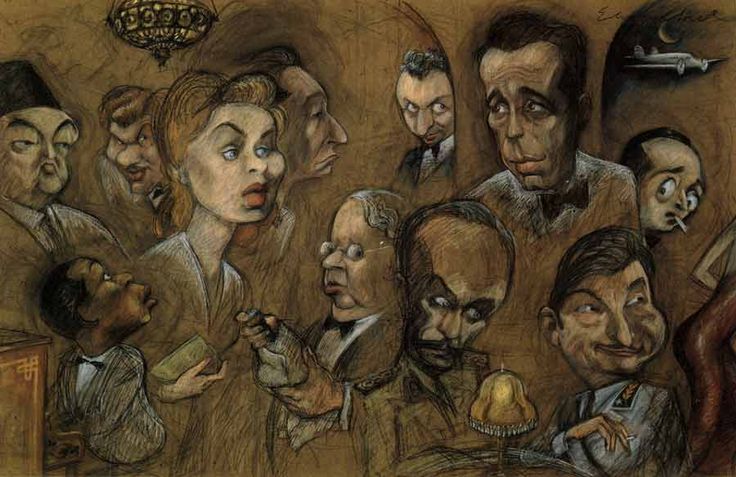
If you want to learn more about MR. Sorel and his work here is a short documentary on Mr. Sorel done by his son Leo Sorel.
If you still haven’t had enough below is a superb Interview that Sorel gave to THE COMICS JOURNAL in 1991 and fully illustrated is available on the web at http://www.tcj.com/edward-sorels-happy-accidents/. In the interview Sorel talks about his life with the same honesty that is indicative of his work. I also didn’t ask permission of THE COMICS JOURNAL to use it here and if they also want me to remove it all they need do is ask. But as with The New Yorker and Esquire material above, don’t expect me to do it right away as I’ll need to receive some real threatening letters first. If they allow me to leave it on my blog I will, of course, be eternally grateful.
Edward Sorel’s Happy Accidents
BY Gary Groth Jan 17, 2014
Edward Sorel Interview TCJ #158 (April 1993) Copyright TCJ
Emerging from a partnership with some of the most famous and influential graphic designers of the time, Edward Sorel went on to become a celebrated illustrator, writer, and cartoonist whose work graces publications across the cultural spectrum. In 1991, Sorel spoke to the Journal about his life, his art, and his uncanny ability to be in the right place at the wrong time.
CLIMB EVERY MOUNTAIN
EDWARD SOREL: Would you call off this interview if I got a cigarette?
GARY GROTH: No, no.
SOREL: Maybe just one or four or five.
GROTH: Well, I want you at your best. Do you mind if we start?
SOREL: Sure. God did not put me on this earth to make people happy, he put me on earth to be a commercial hack. And that’s what I was for the first 20 years in the field.
GROTH: And those 20 years would have encompassed which years?
SOREL: I got out of Cooper Union in 1951 to look for a job doing mechanicals. Because Cooper Union was an elegant art school, it didn’t teach you how to do mechanicals.
GROTH: For the benefit of our readers, can you tell us what Cooper Union was?
SOREL: Cooper Union was a school started by Peter Cooper around the middle of the 19th century for the education of women. Peter Cooper was the inventor of the first locomotive in America, and a multi-millionaire industrialist and philanthropist. He started this school for women. However, by the time I entered it, which was in 1948, not only was it co-educational, but its essential purpose seemed to be to take young people and turn them into suitable material for advertising agencies. One need not go too deep into whether or not Peter Cooper would approve of this, but it was a school for architects and engineers as well as for artists. But most of the artists, it seemed to me, were taking the graphics course. “Graphics” being a euphemism for commercial art. For all of my professional career, they have found a new word for commercial art every ten years. In the ’50s, we were called graphic designers, in the ’70s, we were called visual communicators. I don’t know what it’s called now, but I’m sure there’s a new euphemism for plain old commercial art. Anyway, my first year out of Cooper, I got fired from 11 jobs — which, I am told by people who know, was a record. However, every time I got fired from a job — and I generally knew a few days ahead of time that I was going to get fired — I would very insidiously take proofs that better designers had done and put them into my portfolio. Every time I got fired from a job, I got a better paying job as a result, and proved even more incompetent than I had been at the last job, so that by the middle of 1951, I was lasting on jobs only about three days before they realized I was unsuited for it.
GROTH: These were staff jobs?
SOREL: These were staff jobs.
GROTH: Like at magazines, publishing companies, advertising agencies?
SOREL: The first job was at William D. McAdams, which was an advertising agency that did pharmaceutical advertising, and particularly clean, pristine advertising, very delicate, and I had the distinction of having one of my pieces printed with my thumbprint on the copy. This was also a first. [Laughter.]
GROTH: I assume you were bounced immediately.
SOREL: Well, it was run by a sweet old commie art director who felt it was wrong to fire a working man, who was after all noble, and even though I didn’t exactly fit into his concept of the noble working man, he was reluctant to fire me. So he tried finding jobs that I could do. He asked me if I could work on an airbrush, and knowing this was my last chance I said yes. He gave me a simple job, I just had to put down a flat color on a background. I tried, and I tried, and I couldn’t get this thing to work, and so finally I went back to him with my little gun, and said, “It doesn’t work!” He looked down at me, and said, “You forgot to take the cap off.” I got fired shortly after that. [Laughter.] Then, as I said, I kept getting better and better jobs. One job was as a chief art director of a printing firm in Newark, New Jersey. They wanted me to do an annual report, and at the end of a week, I still hadn’t designed a single page, I was still “experimenting,” because I remembered doing that in school. Apparently, in the real world, there isn’t much experimentation. [Laughter.] So I got fired from that, but after a year of getting fired, I had a wonderful portfolio. I got a job at Esquire.
GROTH: This would have been in ’52.
SOREL: This would be ’53. Fortunately, the art director at Esquire was also incompetent. But it was a year where anybody who had an Armenian name automatically got $75,000 a year. His name ended with “I-A-N”, but he didn’t know what he was doing.
GROTH: Were you able, therefore, to retain your job?
SOREL: Yes! Exactly. In fact, he was delighted to have someone more incompetent than he was. [Laughter.] So I stayed there for, I would say, 11 months. Then Seymour Chwast, an old classmate, came to work there. Seymour was one of the two most talented guys in my class at Cooper, and I just did whatever Seymour did. Suddenly my work improved. But, after two weeks, they decided to fire half the art staff, including the art director. [Laughter.]
GROTH: Who was left?
SOREL: Well, the guys who knew what they were doing. Henry Wolf, who subsequently became one of the giants of graphic design, had a small, insignificant job, but it was clear to the management that he knew what he was doing. So he became the art director of Esquire after we left. Seymour and I, because we got fired, started Push Pin Studios. Thanks to our unemployment checks, which I think were $30 a week at the time, we were able to start a studio in a cold-water flat, which subsequently became Push Pin. When Milton Glaser returned from Italy he joined us, and the three of us met with enormous success. Two years later, when Push Pin Studios moved from its cold-water loft to fashionable East 57th Street, I decided to leave. My accountant said that this was a poverty wish, similar to a death wish, but somehow different.
GROTH: Worse. [Laughter.]
SOREL: And I’ve been freelancing ever since. No, that isn’t true. After Push Pin, I got a “real” job at CBS as an art director, and I made $175 a week. My mother was still making about $45 a week in a millinery factory, and by getting that job at CBS at $175 a week, I had fulfilled for her the promise of America.
GROTH: Let me skip back a minute. You literally worked at Esquire for two weeks?
SOREL: No. I worked there for 11 months.
GROTH: And Arnold Gingrich was the editor at that time, right?
SOREL: Yes.
GROTH: It was actually a good magazine then, wasn’t it?
SOREL: No. Gingrich was sort of a gray eminence at that time. It was owned by a guy named Smart who I think was in prison at the time I started working there. He had falsified his circulation figures. I didn’t realize you could go to prison for that, but that was the story. Esquire went through ups and downs, but it was a particularly awful magazine during the period I was working for it. It was still using brush-lettering headlines when only the scuzzy men’s magazines were doing that. For an upscale magazine, it was decidedly low-brow. The illustrators were cornball, and the reason, of course, was that Esquire was always a low-paying magazine. I don’t know whether they are today, but Esquire had a reputation for terrible, terrible prices. I remember once, when I was freelancing, refusing a job and telling them to put the NRA label back on their cover.
GROTH: Now, when you were at Cooper Union, what was your ambition at the time? Did you want to be a graphic designer?
SOREL: At Cooper, and for many years after Cooper Union, I had only one ambition in life, and that was to have my own apartment. I really didn’t much care how that came about. I wanted to get laid, and I wanted to have my own apartment, and they were closely tied up with one another. Neither one of those was easy.
GROTH: Which would you say was harder?
SOREL: Well, getting the apartment was always harder. So I figured I would learn how to do mechanicals, and I would work my way up to $45 a week, then $85 a week, and then I would be able to have my own apartment, and then I would get laid, and die a happy, fulfilled man.
GROTH: When you refer to mechanicals, you’re referring to the process of putting pages together for books and magazines, right?
SOREL: Yeah. It didn’t have anything to do with design, simply pasting.
GROTH: You wanted to be a paste-up artist.
SOREL: Yeah, that’s what I wanted to be. I mean, I had no illusions. I couldn’t draw any more. I mean, I was able to draw when I was like 9 years old, but after going to the High School of Music and Art, and Cooper Union, I couldn’t draw any more because they taught design and abstraction. I think there was one Life [Drawing] class in the three years that I spent at Cooper Union. So I couldn’t realistically have any other dreams except to be a good mechanical person. A good paste-up person.
GROTH: Did you ever want to become an illustrator?
SOREL: No. I didn’t have any hard ambitions.
GROTH: Was the School of Visual Arts …
SOREL: At that time, it was called the School of Cartoonists and Illustrators, it hadn’t become SVA. I did take a course there subsequently to learn design, to learn more design, because I figured I might be able to make it as a designer. What seemed like a tragedy at the time was that I could not do mechanicals. For example, it took me a long time to learn to put a push pin underneath the T-square to keep it from falling down. That took me several weeks to learn.
GROTH: That obviously must be a difficult procedure. Can you explain how you do that?
SOREL: Well, you put a push pin into the drawing board, which is at an angle, and that prevents the T-square from crashing down on the floor every five minutes, and making everybody else in the bullpen drop whatever they were working on.
GROTH: This was before lips were invented? [Laughter.]
SOREL: Before what was invented?
GROTH: Lips. You know, the bottom of a drafting board.
SOREL: Oh, yeah, that’s right. Lips hadn’t been invented yet. Until the German engineers came after the war, we didn’t have lips on drawing boards. [Laughter.] In those days, you cut type on illustration boards, and I remember cutting through the illustration board, which was not desirable. [Laughter.] I had a heavy hand.
GROTH: So at what point did you start drawing again?
SOREL: Well, when we started Push Pin Studios. It was really crazy, because the purpose of Push Pin Studios was essentially a freelance studio to get illustration work, and I could no longer do illustration. So, I guess, although I don’t remember it clearly, I must have wanted to be an illustrator even though I couldn’t do it. When Milton [Glaser] came back, I started doing whatever Milton did, and I must say, in all fairness to myself, I was not unique in that. Half the people who went to work for Push Pin Studios ended up doing little Milton Glasers. What he did seemed so easy and so effortless that it seemed you could do it too.
GROTH: Well, now, Glaser was not an illustrator, he was a designer, wasn’t he?
SOREL: No, he was an illustrator, too. He started out strictly as an illustrator, but he went on to become everything. He became a designer, an architect, interior designer, philosopher, man-about-town, raconteur, friend, consultant to everybody. Milton exuded confidence. Heads of large corporations felt confident when they talked to Milton because Milton had an air of benign condescension, no matter who he was talking to. That reassured the titans of industry that they were in good hands.
GROTH: OK, so you started drawing and becoming an illustrator at Push Pin. How did you go about doing this?
SOREL: Well, I didn’t. Actually, since I drew least well (I couldn’t draw as well as Seymour or Milton), I became the salesman. In spite of the fact that I only had one suit and couldn’t talk too clearly, I was the salesman because they could draw, and this went on for a while until they were able to hire someone with several suits, and I was back on the drawing board doing whatever I could, which wasn’t very much. I’m not being modest. I literally could not draw at that time. What I did was a kind of cut-paper thing.
GROTH: So at what point did you develop the skills you now display so well?
SOREL: Well, I began plagiarizing, which I insist on thinking is the way everyone should start. I figured on freelancing as a designer, but there wasn’t any photostat house near where I lived, so I figured I better do illustration. I got a portfolio together, essentially a catalog of all the techniques that were currently popular.
GROTH: From whom did you plagiarize at that time?
SOREL: Joseph Low is one of the ones I remember, nobody remembers him anymore. I certainly plagiarized from Milton. Just about anybody who was ….
GROTH: Any cartoonists?
SOREL: I wasn’t doing cartooning, I was doing decorative illustration, which was quite a different animal. The purpose of it was to be cute and inoffensive, and it was the kind of illustration where everybody smiles, and everybody’s white and has small noses. As opposed to cartooning where people are angry and have big noses.
GROTH: Were you at all interested in cartooning at the time?
SOREL: No, because I was filled with insecurity, and figured that I didn’t know how to be funny. Being funny was for superior people who had a sense of humor. I just wanted to be a pair of hands for art. I knew, somehow or other, that I had the hands that could do anything. I just couldn’t do anything original. [Laughs.] When I teach I try to tell my students that I didn’t do a good drawing — a personal drawing that was recognizable as being my own — until I was 40. They find this hard to believe. If I were Catholic, I might become the patron saint of late starters. I just kept working at it, and working at it and working at it until I suddenly discovered at the age of 40 that if I did a drawing in pen and ink without tracing — without penciling, without tracing of any kind — that my drawings had a life to them that they hadn’t had until then. In 1970, my wife wrote a book called Wordpeople, which was about people whose names had become part of the English language. Like sandwich, and boycott and nicotine, which comes from Nicole, people like that. I promised myself that I would do all of those drawings without tracing, and it never occurred to me that these drawings, which were personal, had any commercial use because they were not innocuous they were not happy, they were not clean. They didn’t have a clean line. They were kind of spastic. But it turned out the only thing I could offer was a kind of spontaneous line drawing, it was the only unique thing that I could do.
GROTH: So are you saying that it wasn’t until you were 40 that you actually did drawings for the love of it?
SOREL: I never did drawings for the love of it. I still don’t do drawings for the love of it. In the last 40 years I have only done one drawing without a purchase order.
GROTH: Excluding the cover of this magazine, right?
SOREL: If you want it on time, you’ll send me a purchase order. [Laughs.]
GROTH: So yours was a purely commercial orientation. But it appears to me that a lot of the stuff you do for The Nation, a lot of the portraits of film stars and so forth, that there’s a certain amount of, if not love, passion.
SOREL: The passion is there. The movies were the things that got me through childhood and adolescence. In those days when the studio system was going strong, you would see the same supporting actors in the movies week after week. Thomas Mitchell, Donald Meek, and these became my family, the family that was interesting. So I was a big movie buff when I was young, and the movie things that I do now are my homage to the movies that I saw.
EVERYONE’S A CRITIC
GROTH: Let me skip back because I didn’t cover this, but are you a native New Yorker?
SOREL: Yeah.
GROTH: Born and raised.
SOREL: Born in the Bronx, and I must say that New York, at the time I was growing up was, for poor people, Utopia. The museums were free, the schools were free, and fairly good, though the Bronx was essentially a shetl.
GROTH: A what?
SOREL: A shetl. A Yiddish word. Shetl was the Jewish town in Europe that was essentially made up entirely of Jews. The Bronx was pretty much like that. There were a few blocks in the north Bronx where the Irish lived, but essentially where I lived they were all Jews, only the superintendents were goyim. Going to the High School of Music and Art was the first chance to get out of the shetl and meet people who were from different walks of life, and educated and rich and so forth. Even more than a fan of the movies, I’m a fan of New York, and even in its current last days, I have a tremendous affection for the city.
GROTH: Were you middle-class?
SOREL: No, we were poor. We were honest-to-God poor.
GROTH: What did your father do?
SOREL: Slept on the sofa. [Laughs.] What did yours do?
GROTH: Joined the Navy.
SOREL: Well, I suppose if my father had ambitions he could have done that. Actually, my father came to America to escape conscription in the Polish army, and of course, the first thing he wanted for his son was to send him to military school to make a man out of him, as opposed to sitting all day in the house making pictures on shirt cardboard. Fortunately, we didn’t have enough money for military school, and so I was saved.
GROTH: Getting back to the ’50s, notwithstanding this commercial orientation, did you have ambitions to be an artist? Did you enjoy illustrators or cartooning?
SOREL: Yes, I was a great fan. It seems to me that my hero, my big hero when I was at Cooper Union, was Andre Francois, and Ronald Searle, and a little later Topolski, Felix Topolski. In retrospect, I can see where my love of Topolski comes through in some of my drawings. Some of the people who my work reminds me of weren’t my heroes. John Groth for example. I don’t know if you know his work. He was the first art director of Esquire, by the way. Then I discovered the work of Heinrich Kley. What saved me was that I had good taste buds, by which I mean I preferred Andre Francois to Jack Davis. [Laughs.] One of the most distressing things in my brief period of teaching was the realization that most of the students there wanted to be Jack Davis. I was not the person to help them. [Laughs.]
GROTH: When did you teach?
SOREL: Oh, about 10 years ago, I taught one year at Parsons and one year at SVA.
GROTH: Was that an experience you enjoyed?
SOREL: No, it was very distressing. When Seymour and Milton and I were at Cooper Union, we were first-generation Americans and came from poor families. Seymour had the distinction of being even poorer than I was since he was on welfare. For us, commercial art was a tremendous step up from our parents, who were working in factories. We were hungry to learn, and we wanted desperately to succeed in what we assumed was a difficult field to get into. Teaching now is very different because you have the sons and daughters of dentists and doctors and lawyers who want to go into art because there are no critical standards for art, and they figure they can do anything. They are lazy and unmotivated and untalented.
GROTH: Seems like the perfect fodder for an ambitious teacher.
SOREL: [Laughs.] Right.
GROTH: No challenge there. When you took a class at SVA, did you know Burne Hogarth?
SOREL: No. What ever happened to Burne Hogarth?
GROTH: Oh, he’s alive and quite … well. I know Burne quite well. We lived on the same coast at the same time and would get together frequently. He is … I mean, if you know anything about him, he’s still as volatile …
SOREL: I know nothing about him. The guy I’ve always been curious about is Robert Crumb. Crumb draws really well. That’s what you can’t fake.
GROTH: Crumb doesn’t think he draws well.
SOREL: Well, there you are. Would you call that modesty? Sure! You don’t call that false. I mean, if you’re really into drawing, you always fear your inadequacy.
GROTH: You were in an issue of Raw, an issue or two ago. How would you assess the drawing skills of the people in Raw?
SOREL: Oh, they’re awful. I’m so glad to have this interview because I’d never have the courage to say that to Art. I think it’s awful. I think, first of all, there is something to be said: some of my favorite artists are klutzy drawers. There was a guy named Alfred Kubin who drew for Simplicissimus who couldn’t draw, but he had so much passion in his stuff that it really didn’t matter. By the same token, Art Spiegelman, who I don’t think draws well, has so much passion in his Maus that the whole thing works beautifully. I give a lot of points for passion. I’m not particularly interested in drawing that is naturalistic.
GROTH: Well, I was going to say that draftsmanship by itself doesn’t really mean a lot, because you can be awfully sterile if you don’t incorporate an interpretive dimension to your work.
SOREL: Yeah, yeah.
GROTH: Now, you don’t pay any real attention to comic books?
SOREL: No.
GROTH: Would that disinterest include newspaper strips?
SOREL: Well, if we’re talking about newspaper strips, we’re talking about 30 years ago, because who can read the newspaper strips now? They’re all on microfilm.
GROTH: [Laughs.] Are you the only person in the world who doesn’t adore Calvin and Hobbes?
SOREL: I, uh … don’t really … what … is that a dog?
GROTH: No, that’s the kid and the tiger … Bill Watterson?
SOREL: Oh yeah, yeah, I’ve seen it. Well, I don’t read any newspaper that has comic strips.
GROTH: Oh yeah, that’s right. You snobs out here only read The New York Times.
SOREL: That’s right. I actually only read the movie section. It’s a problem.
GROTH: To get back to your career, one thing you didn’t mention was that you had a book published in 1959 by Grove Press.
SOREL: Oh yes! How to Be President. How did you know that?
GROTH: We have spies …
SOREL: 1960. Kennedy was running for president when I did How to be President. It was kind of a sophomoric little book. It’s kind of silly, and I didn’t know how to draw yet. What’s great about the field is that they pay you while you’re learning. I got a lot of stuff printed before I really knew how to draw.
GROTH: Well, it’s never been truer than today. Now, Grove Press was run by Barney Rosset. Did you have any dealings with him?
SOREL: Oh sure, he was the one that took the book.
GROTH: What was he like? What was Grove Press like at the time?
SOREL: I only had one or two meetings with him, but one meeting stuck in my mind, because he had a French humor magazine that had a lot of cartoons in it. I came in one day to his office and he was giggling over some cartoon, and he couldn’t wait to show it to me; it was a scene in the concentration camp. It showed the Jews in the middle of winter. There was snow on the ground and a bunch of Jews warming themselves on the walls of the crematorium. He thought that was very funny. I realized immediately that Barney Rossett was not “just folks.” [Laughs.] Well, he was actually just ahead of his time. Sick humor was really in flower 10 years later. But that was my only encounter with Barney Rossett.
GROTH: You know, he also published pornography to keep the literary stuff flowing.
SOREL: Well, I was more visually oriented so I read little of that stuff. The other thing that distresses me about our times is that skin magazines seems to be obsessed with genitalia. I grew up when frontal nudity was quite enough to excite the young boy. You know, I did a cartoon in Penthouse every month, and my dealings with them were extremely happy, because they pretty much let me do whatever I wanted every month. [Sorel left Penthouse in November, 1992.] But the magazine itself is shocking to a boy brought up in the ’50s. It seems to me more appropriate to a medical magazine than a … well, anyway …
GROTH: You find it problematic morally, or aesthetically?
SOREL: Well, when my daughter went to college, she was once teased by some boys, because it was discovered that her father was doing a page in Penthouse. She made me feel that this was a wrong thing for me to be doing, so I left Penthouse for a period of something like five years, until she was through with college. Then I went back. [Laughs.] I don’t even think they were teasing her so much as they had discovered this fact, and she, being a feminist as all my daughters are, felt that it was very wrong of me to be a part of this vile magazine. I was very sympathetic. On the other hand …
GROTH: Not sympathetic enough to not go back to it, though.
SOREL: Well, there aren’t that many magazines that will let me do what I want to do. What’s important to me is my page. This may be a rationalization, but to me it’s more important to be able to do what I want to do than to be a part of a magazine that … I enjoyed doing my page in Penthouse much more than I enjoy doing a cover of an entire magazine where I cannot do anything at all acerbic or meaningful.
GROTH: Sounds a little like Howard Roarke from The Fountainhead.
SOREL: Although I’m left-wing, every now and then some piece of fascist philosophy hits very close to home, and I’m certainly sympathetic to Ayn Rand’s notion of competence. I like Ayn Rand for two reasons: one, she was an outspoken atheist, and two, her God was competence, and I’m inclined to go along with that.
GROTH: Did you go along with this only when you became competent?
SOREL: [Laughs.] Yes. Until then I was very sympathetic to people who couldn’t do their job.
OH, MY BLEEDING HEART
GROTH: In 1963, Simon and Shuster published Moon Missing. Can you tell me what that was?
SOREL: Well, I’ll always be very grateful to Moon Missing. While I was having my nervous breakdown after my first marriage collapsed, I went to Quaker meetings. I thought it would be a good idea for me to be concerned with troubles other than my own. At a meeting, I met a woman during the coffee break, and I was able to let drop that I had a book out, which was Moon Missing. I think she assumed that I was a writer, rather than a cartoonist, and so she became impressed enough that we went out to breakfast, and we fell in love and we got married, and lived happily ever after. So I’ll always be grateful to Moon Missing for that. Moon Missing was a fantasy that was about what happens in the world when the moon disappears. It used people who were very much in the limelight at the time. Moon Missing was published by Simon & Shuster, who had a half-page ad set to appear in The New York Times on a Monday morning. Unfortunately, it was the Monday morning that the newspaper strike started, and that was the end of Moon Missing, which was remaindered along with all of the other books that couldn’t be publicized. The story of my life is a whole series of stories like that, which leads me to believe that there is a God and he’s pissed off at me. For example, I don’t know if you know my poster of Cardinal Spellman, that was done at the peak of the Vietnam War.
GROTH: “Praise the Lord and Pass the Ammo.” I was going to ask you about that.
SOREL: Yes. “Pass the Lord and Praise the Ammunition.” Right. Well, that poster … that was really one of the happiest days of my life when Personality Posters said that they would make a poster out of this drawing, which everybody, every magazine refused to publish — even Ramparts refused to publish it. It was somehow too sacrilegious. Here he was going to make a poster of it and I would be famous at last. The day that poster got off the press was the day that Cardinal Spellman died, and that poster was not sold anyplace in the United States. It was sold in one store in Chicago that had its window broken for selling it.
GROTH: What year was that?
SOREL: That was 1968 or so.
GROTH: Can you explain what Spellman represented socially and theologically?
SOREL: Well, he represented the continuation of the long line of reactionary fatheads in the Catholic Church. People forget that he had gone over to Vietnam and assured the soldiers that they were friends of Christ’s simply because they were over there. A tradition, I believe, carried on by Cardinal Cook, who was his successor. Much of my cartooning is anti-clerical, which explains why I appear in The Nation instead of … I don’t know. Is there a magazine that, uh …
GROTH: National Review, maybe.
SOREL: Well, I wasn’t thinking so much of that, but I was thinking of the magazine everybody reads.
GROTH: Time magazine, maybe.
SOREL: Yes. There is no magazine now that everybody reads, which is another thing … people always ask me why I’m depressed, and the reason is that pictures that don’t move seem to be something of an anachronism. Everything is animation, television, and sometimes I feel that this is a transitional period, and I might just be lucky enough to live out my life making the same pictures that I’ve always made. But I don’t know why anyone would want to go into this field now if they were young, it all seems so downhill. What you are doing is …
GROTH: [Chuckles.] Let’s not get into the word “grim”.
SOREL: Have you thought of buying a television station?
GROTH: Yeah. Well, you are one step ahead of prose writers, anyway …
SOREL: There’s that. It’s a very rare profession that you can do all your life without suddenly being an anachronism.
GROTH: Depressing subject. Somehow we took off from Cardinal Spellman … You went on in the ’60s, I think, to work for The Realist and Ramparts.
SOREL: The Realist was my first. ’65, maybe.
GROTH: That was a real iconoclastic newsletter. It wasn’t quite what you’d call a magazine, was it? It was smaller.
SOREL: No, it was Time-size, just printed on cheap paper, and printed cheaply, but if a thing has a staple in it, it’s a magazine. The thing about being a cartoonist, as we were talking about before, is that I keep being thrown in with people who are eccentric, interesting, and offbeat, and I always find myself in the position of being the straight white man who’s an unexciting conformist. And that’s how I felt whenever I was with Paul Krassner — he was clearly living in a netherworld very different from my middle-class yuppiedom. I mean, I had worked so hard to get my own apartment, and to be able to eat in a fairly good restaurant, that I wasn’t going to give it up in middle age for his waterbeds and joints.
GROTH: [Laughs.] Well, that’s interesting. Did you always aspire to become middle-class? You once referred to yourself, or your lifestyle, as bourgeois.
SOREL: Uh, yeah. Yes.
GROTH: Did you have any difficulty reconciling that with your radical political stance?
SOREL: None whatsoever. [Much laughter.] The one bit of celebrity that I’ve enjoyed was because of the Nation cartoon about Frances Lear. Frances Lear, you might remember, got 114 million dollars as a divorce settlement from Norman Lear, and then started this magazine called Lear’s. When the magazine first came out, she was having a lot of television interviews, the thrust of which was that all women should do what she did. It’s never too late to start a new life. (She being over 60 at the time.) So I did a cartoon which I thought pointed out the differences between Lear and other women who don’t have 114 million to fulfill themselves. Nevertheless, the 34 members of The Nation’s staff protested the inclusion of this cartoon as being male chauvinist. Anti-woman. A little notice was placed on the page before my cartoon, explaining that the cartoon which you are about to read on the next page has been published over the objections of 34 members of The Nation’s staff. Well, as soon as that happens, all the mainstream publications, who are always waiting to make fun of the left, hopped on the bandwagon, and pretty soon I was being quoted in Newsweek and The Washington Post and all the other magazines, and this whole thing was blown way out of proportion. Anyway, as a result of these 34 members objecting to my cartoon, The Nation got hundreds of letters, some of which said they didn’t see anything chauvinist about the cartoon, but the vast majority of which were from women who said “How can you print this stuff, the guy can’t even draw.”
But one letter in particular pointed out that at the time the cartoon appeared, I was doing a lot of drawings for Manufacturers Hanover, which was a bank that had lent money to every fascist government in South America and had investments in South Africa and all the other things which you can say about almost every bank. They accused me of trying to rationalize working for banks. I answered that I’ve never tried to rationalize my working for banks to my politically-correct friends any more than I’ve tried to rationalize working for The Nation to my accountant. My favorite line is Fitzgerald’s, who said that the sign of a first-rate mind is the ability to keep two conflicting ideas in the head at the same time and still function. I’m able to keep the conflict of wishing for something better than American capitalism while working for American capitalists.
GROTH: Well, let me see if I can formulate a question about all of that. It was advertising drawings you did for the Manufacturers Hanover? That seems like a fairly serious …
SOREL: Breach?
GROTH: Yeah. I mean, as opposed to a lesser breach, I guess … Do you think it’s a matter of degree?
SOREL: Well, I feel rather secure this week, because last week I turned down what would have been a campaign for over a hundred thousand dollars for Phillip Morris. Phillip Morris is coming out with a new cigarette soon called BH, which stands for Benson & Hedges. They wanted me to do pictures that had absolutely nothing to do with smoking, historical pictures like Henry VIII knighting a roast loin or something of that sort. The pictures themselves were quite innocuous, but I couldn’t bring myself to work with cigarettes. That seemed beyond the pale. Working for banks doesn’t seem beyond the pale, but I can see how one could make a case that it is. That’s all I can say about it.
GROTH: Especially since you smoke.
SOREL: Yes. But …
GROTH: But you don’t invest in South Africa.
SOREL: [Laughter.] Yes, good point, but …
GROTH: You’re a consistent hypocrite, Ed.
SOREL: Yes, yes. It’s true.
GROTH: I guess, in a way, satire is prescriptive in the sense that you’re saying she or he shouldn’t do this, and your commentary on Lear essentially said that hers was a fatuous position to take: counseling women who don’t have 114 million dollars to go out and become themselves.
SOREL: Well, as I said, just put it down to sheer hypocrisy and let it go at that. I won’t defend myself.
GROTH: We sort of got sidetracked from Krassner and The Realist. Can you give me a sense of what it was like working for him, and those days in general? What your life was like?
SOREL: I’m sorry, I can’t. He had an office in what was then the poorest part of New York, I think on Avenue C. I enjoyed his point-of-view, obviously. I had been reading The Realist, and approved of his iconoclasm, and his absolute rejection of good taste. But I know nothing about him. I realize that he’s something of a cult figure, and I’d love to be able to add to the legend, but I had very short dealings with him.
GROTH: Well, was it heady in those days? The mid-to-late ’60s was a pretty volatile period and you were getting more politically active. Was there a sense of excitement?
SOREL: You don’t have children. Everything changes … I was married and had children. Everything passed me by … the sexual revolution, the political revolution, the protests, everything. My concern was, as I said, survival, and what I enjoyed, certainly after my second marriage, was being at home working, and playing a game of Scrabble at night. I am not a romantic figure out of some Fitzgerald novel. I am every bit as dull as I say I am.
GROTH: [Laughs.] And yet, you do have strong political convictions that you …
SOREL: That’s the dullest part of me. What can be duller than having somebody at the dinner table with strong political opinions? Even I wouldn’t deign to talk politics at the dinner table. Politics are really boring. The only thing that’s mildly interesting is the hypocrisy of those in power, which makes my little hypocrisy seem like nothing. What I’m reacting to is the chicanery and the double-talk of those who lead us. I am not involved in politics from an ideological point-of-view, like Art Young, who is a true believer that socialism would save the world, or that communism would save the world. Or Pete Seeger, who really believes that man is really a noble animal. I don’t have any of these preconceived notions. I am simply reacting with a gut feeling to what I know is stupidity. This concern with fetuses, for example is a perfect example. I mean, to live at a time when we have presidents who are more concerned about fetuses than human life.
GROTH: Uh-oh. Getting yourself in trouble here. [Giggles.]
Cover illustration to Superpen: The Cartoons and Caricatures of Edward Sorel © 1977
SOREL: Yes, well. I insist there is a difference between killing someone in their 20s, and killing someone who’s a blob …
GROTH: You’re getting yourself in deeper and deeper.
SOREL: Well.
GROTH: You referred to your daughter as being feminist. You lived through the feminist revolution, the ’60s and ’70s. How did you react to that, and what were your feelings about feminism and the women’s movement?
SOREL: It was so hard for me to get laid, it was almost as hard for me to get laid in the ’50s as it was to learn how to draw, and so I’ve come to feminism rather slowly. However, of course, I’m sympathetic to the concerns of my daughters, and I know what they are talking about, and I sympathize with them and support them. Knowing, of course, that deep down I’m just a male chauvinist pig, but I am trying. [Laughs.]
GROTH: Did you study politics, or are your political convictions mostly vestigial from your parents and from your upbringing?
SOREL: Well, I’m an anti, I’m not a pro. I’m reacting against what I am certain is stupidity and hypocrisy. I am not making cartoons about how marvelous the unions are, or how noble the working man is. That’s not my schtick, and I don’t know how one can be funny and be pro. To me, humor is essentially being anti.
GROTH: On the other hand, you’re probably like a welfare liberal, which you wouldn’t have to be just to be anti rather than pro. You could be against liberal programs as easily as you’re against conservative ones. Chances are, you probably believe the poor ought to be helped as opposed to the Republican doctrine, which believes the best way to help them is to slash welfare payments and build more prisons …
SOREL: Well, I believe that the poor should have the opportunity of working. The rich say the poor don’t want to work, but you and I know different. When you’re living in a society that is essentially a game of musical chairs, where somebody is always left standing, it seems to me to be particularly cruel to accuse the person left without a chair of not wanting to sit down.
GROTH: That reminds me of a great passage — I think it was in Les Misérables, where they passed a very equitable law declaring that neither the poor nor the rich can sleep under bridges.
SOREL: Right. I think, actually, it was Anatole France who used that line.
PETTY BOOSHWAH
GROTH: How involved were you with Ramparts?
SOREL: Well, Ramparts was on the West Coast and I was on the East Coast. So I couldn’t be too much involved with them. Every now and then I meet some of them who are now in the East.
GROTH: Yeah. They were the same people Steadman started with over here, as a matter of fact.
SOREL: Oh, really? I didn’t know that. Ironically the people I was involved with were mainstream magazines. I was a contributing editor of New York magazine from the very beginning, and when Clay Felker lost the magazine I left it along with everybody else. Not that I felt that New York could be much worse than it was, but it just sort of seemed like the loyal thing to do.
GROTH: What does being a contributing editor to New York magazine consist of?
SOREL: Well, it meant that I would give them ideas for features. I remember doing four pages on the rise and fall of the New York City Taxicab, which was not political, it was just … I mean, it doesn’t take much to get me angry. I was angry at how uncomfortable taxis had become, and I couldn’t understand why the rich, who took taxis, allowed this to happen.
GROTH: If they are good for nothing else, they should be good for forcing taxis to be more comfortable.
SOREL: Yes! Well, of course, as soon as the economy changed, then the middle-class started taking taxis, the rich started taking limousines. So at five o’clock you have a lot of limousines waiting on Madison Ave.
GROTH: As well you should.
SOREL: Yeah. This business of being bourgeois … I think people who don’t enjoy good food and pleasant places to live are perhaps admirable, but they are … they’re unusual. There’s a marvelous line in an old Myrna Loy movie where the character says, “Some people think movies should be more like real life. I think real life should be more like movies.” And my feeling is that everybody should be able to have good food, and live comfortably, and I don’t think it’s going to do anybody any good if I live a life of stoic denial. I realize that I’m talking to the wrong man about this …
GROTH: No, I can appreciate comfort. There’s a limit to discomfort and inconvenience, you know. You have to draw the line somewhere. That Myrna Loy line brings to mind something a friend of mine wrote recently. He said the current buzz is that comics are becoming more like life, and reflecting real life, and he said, no, it’s really just that real life is becoming more like comics. It seems to be accurate. [Much laughter.]
SOREL: Yes, that’s it.
GROTH: More absurd, more ridiculous, more outrageous. At what point in your career did you start seeing your peers and socializing with other cartoonists?
SOREL: Never. There’s no community. These days all sense of community in a big city is gone.
GROTH: And it was gone even back then?
SOREL: Seems that way to me. I occasionally see Jules Feiffer, but not nearly as much as I would like to. Everybody’s spread out. Even if you live in the city, somehow, you don’t get to see people. Who do I see? I see Arnold Roth occasionally, I see David Levine occasionally, as far as cartoonists, that’s about it. I don’t see illustrators. Illustrators are even duller than I am.
GROTH: No wonder you didn’t turn me away at your door.
SOREL: Oh, yeah, editors are OK.
GROTH: Well, that’s funny, because I thought, particularly in New York, there would be a sense of community among illustrators and cartoonists.
SOREL: Well, there’s no more free time. The only time you see anyone anymore is if you give a dinner party. That’s the only time I see people.
GROTH: Jesus.
SOREL: Well, you see a lot of people because of the nature of your work.
GROTH: Yeah.
SOREL: And my work is solitary.
GROTH: Do you ever have misgivings that you chose a solitary profession?
SOREL: Oh no, I really don’t like people too much. I really don’t, and now that the children have left the nest, and I’m alone with my wife, it’s very much like living in sin, so I’m enjoying it immensely.
GROTH: You really don’t need community with…
SOREL: No. When you have a wife and a good bakery, you really don’t need people. [Laughter.]
GROTH: It’s probably fortunate that you didn’t choose a profession where you had to deal with all those goddamn people out there.
SOREL: You know, I tried it. I mean, I used to have straight jobs, I used to work on staff. I don’t know, it seems to me that as soon as you have more than two people, there’s a power struggle.
GROTH: It seems to me like when you have more than one person, there’s a power struggle, [Laughter.]
SOREL: Well, listen, if you are going to try to one-up me as far as cynicism, we can stop now. If there is one thing I can’t stand is a person more cynical than I am. [Laughs.]
GROTH: That’s almost exactly what Ralph Steadman said to me. It worries me. [Laughter.]
SOREL: Well, you’re the boss of what you do, but when you’re in the middle there, working in a big corporate thing, everybody’s trying to get ahead, and everybody’s jealous of everybody else, and it’s mankind at its worst! However, I do miss the two-hour lunches.
GROTH: When did you start doing the Hollywood portraits and caricatures? Caricatures or portraits? They seem to lie somewhere in between.
SOREL: I do something in Esquire called Movie Classics. That’s kind of interesting. Well, as interesting as any cartoonist can be. [Laughter.] I did it because of my great love of movies. The idea was I would caricature a scene from a movie, give a few lines of dialogue, tell something about the making of the movie. Essentially trivia about the movie. Esquire liked it tremendously, and I did it for about a year, but I suddenly realized that I could not escape the photograph. That after looking at all my pictures, although they were caricatures, often done in pen and ink, that I could see the photograph underneath. It wasn’t the way I visualized it, so I stopped doing it after a year.
Right now, I’m doing my Sistine Chapel. I’m doing a double page spread in full color on Casablanca for an article I’m writing in American Heritage. I’m doing three to five thousand words on the making of Casablanca, and caricaturing every minor character that appeared in it. I think I’ve gotten 18 — 18 people who appeared in Casablanca. I’ve been working on it now, on and off, and I still haven’t gotten it right. After this, I’m just going to do small stuff, but this I’m determined will have nothing to do with any photograph you’ve ever seen of Casablanca. It will be very subjective and interpretive of the movie.
GROTH: At what point did you learn how to use color? And how?
SOREL: Well, color is so easy that it didn’t require learning. I can’t understand why anybody ever has trouble with color. Color’s easy.
GROTH: Other artists say that they struggle with it, and still don’t get it.
SOREL: It’s the easiest thing in the world. All you do is put down a ground. You know what a ground is?
GROTH: Yeah.
SOREL: In other words, you put a color …
GROTH: … over the entire canvas or surface.
SOREL: Yeah! And then whatever color you put over it, it holds together, because it’s got that color underneath it, especially if you’re working with watercolor. So all my color is terrific, because of this very simple trick.
GROTH: Well, what medium do you use?
SOREL: Just watercolor.
GROTH: Really? [Surprised.]
SOREL: Oh, you mean the pastels …
GROTH: Yeah.
SOREL: Well, in the pastels you’ve got the color of the paper, which does the same thing that the ground does. But I wouldn’t know how to use color if I was just working on a white sheet of paper.
GROTH: So the surface is never white, it’s always …
SOREL: No, the surface is never, never white. No, I don’t know how people do that. [Laughs.]
GROTH: You’re sure you aren’t revealing a trade secret that nobody knows?
SOREL: No, I’m perfectly open with … When I taught, I showed the kids exactly what I was doing … I love to share everything that I’ve learned.
GROTH: Would the base color usually be like an earth color?
SOREL: No, it doesn’t have to be. If it’s a night scene you could do everything in blue.
GROTH: I see. And that’s all there is to it?
SOREL: That’s all there is to it.
GROTH: Well, OK, but how did you learn to complement colors and how to balance colors?
SOREL: I don’t know what anybody needs to know about color. I mean, that’s easy. Drawing is hard, color is easy.
GROTH: Well, you know, there are colorists in comics. I mean, there are pencilers, inkers, letterers. There are colorists, and there are bad colorists and good colorists. You know, you can distinguish between good and bad, so everyone can’t be equally good at it. I mean, a good color sense isn’t natural to the species, like walking — something most people can do instinctively.
SOREL: Well, some people walk more gracefully than others. [Significant pause.]
GROTH: That’s true.
SOREL: Can’t help you. [Laughs.]
MOVIE CLASSICS
GROTH: Let’s talk about movies for a minute. I was wondering what your favorite films are like. I mean, is there a particular type or genre or period that you’re especially fond of?
SOREL: Well, yeah. I’m not interested in any movie done after World War II, actually. Well, maybe one, I guess. Shampoo, a particular favorite of mine. But, um …
GROTH: Now wait a minute, you have to like The Third Man.
SOREL: Yeah, but that was done in Britain. But you’re right. I do love it. Carol Reed is essentially a ’30s director.
GROTH: When are you going to do your homage to The Third Man? That is something I would raise money for.
SOREL: When I learn how to do my movie caricatures, I’ll go back, and the first one I’ll do will be The Third Man. Incidentally, did you know that the most famous line from The Third Man, about the Swiss and the cuckoo clock was —
GROTH: — written by Orson Welles.
SOREL: Written by Orson Welles. You did know that. You see? You are knowledgeable about … One of the pictures over there [on the wall], by the way, is Orson Welles meeting Randolph Hearst. Of course, we only have Orson Welles’ word for this meeting.
GROTH: Well, that’s good enough. Good enough for a painting, anyway. So you are an aficionado mostly of the ’30s and ’40s?
SOREL: I’m an aficionado of the movies that I grew up with. And I think that as a general truism (if that’s not a redundancy), people love the music that they grew up with, and the art they grew up with. That’s why people steal Dick Tracy comic strips from the Comic Strip Museum. I’m sure it was someone over 40. Over 50. You love what you grew up with, and I love the movies that I grew up with. There was something … for one thing, now that all movies are done on location, and are very naturalistic, we see how false the lighting was in the ’30s. I guess that’s what I like best about it, I like the clearly make-believe aspect of the movies.
GROTH: Were you a fan of particular actors? Cagney or Bogart …
SOREL: Well, I was always a snob, so my favorite actor was Jean Gabin. But no, I like the usual ones that everybody else liked, Spencer Tracy and Bogart and so on. I liked all kinds of movies. A romantic movie that almost nobody knows is I Know Where I’m Going. Have you ever seen that?
GROTH: No.
SOREL: There’s a movie called I Know Where I’m Going with Wendy Hiller and Roger Livesly. Sometimes it’s shown on PBS. Better yet, try to see it in a movie house. That’s a great movie.
GROTH: A romantic drama?
SOREL: There’s no drama. It’s just a romantic comedy. I like The Awful Truth, Double Indemnity, The Maltese Falcon, the usual.
GROTH: I’ve always liked Ben Jonson, too. I saw him recently, again, in The Last Picture Show, and he was excellent. In fact, the movie was so good it was hard to believe Peter Bogdanovich directed it. It was better than it had any right to be.
SOREL: Everybody has their good days. Don Ameche happens to be an exception. [Laughter.] But when I was growing up, I would go to see a Bing Crosby movie, and I never could understand why anybody would go to see a Bing Crosby movie. He seemed so flabby and tired, and then I saw him from the early ’30s, and he was beautiful and amusing. The nice thing about being a cartoonist, by the way, is that unlike being a comedian, it’s possible to be an old fart and be funny, because nobody is looking at me, they are looking at my work. That seemed to me especially true of comedians. Even Cary Grant, whom I enjoyed so, when he was trying to be cute and charming in his 50s and 60s, seemed embarrassing. So aren’t we lucky to be able to hide behind our pictures?
GROTH: Do you like Hitchcock?
SOREL: Well, I loved The 39 Steps, loved The Lady Vanishes, but the plots were so unbelievable. To enjoy a movie, just because of the incredible photography and angles and stuff, I’m not one for that. It all has to come together along with the story. I think Hitchcock had no real interest in people or emotions, it’s all plot. Well, I have a theory about movies, and that is that it isn’t the director that’s the auteur, but that it’s the movie star that’s the auteur. I think that the reason I like The 39 Steps is because of Robert Donat and Madeleine Carroll. It’s the actors in the final analysis that hold us, not the director. John Huston and Billy Wilder were about as good as directors could be.
GROTH: Yeah. Do you like George Sanders?
SOREL: Oh Yeah. In fact, he inspired the funniest line, I think, I had in a cartoon. I did a cartoon about what terrible people artists are, and when I spoke about Gauguin, I said, “Gauguin was such a bastard that when they made a movie about his life, the only guy they could find to play him was George Sanders.”
I loved George Sanders. Well, the good ones were always easy to love.
GROTH: Did you like All About Eve?
SOREL: Yeah. All About Eve. Although of course it’s not much fun liking a movie that everybody else likes.
GROTH: So you’re not partial to actors who came up in the ’60s, ’70s, and ’80s, Jack Nicholson, Clint Eastwood, Dustin Hoffman?
SOREL: Well, you know, it’s sort of like, the way you’re in love when you’re 16 is not the way you’re in love when you’re 50. The way you react to movie stars when you are growing up is not the way you react to movie stars as a grown-up. It’s difficult to look upon them as heroes, or larger-than-life. They’re just actors doing their job. So I’m sure, intellectually, that Jack Nicholson is just as interesting an actor as William Powell, and probably a better actor. But for me, William Powell, who never seemed to act in his life, is the person I still want to grow up to be like. [Laughs.] I don’t want to grow up to be like any of the actors that are acting now.
GROTH: Like these psychopaths.
SOREL: Right. [Laughs.]
GROTH: Well, you’re definitely out of touch with the youth market. They all want to grow up to be psychopaths.
SOREL: I think I’ve even lost the middle-age bracket. [Laughs.] I’m the Geritol cartoonist.
GROTH: The Thin Man movies I thought were marvelous. The first two at least.
SOREL: Yeah, the first one.
GROTH: Myrna Loy just couldn’t be beat.
SOREL: Yes, I actually met Myrna Loy not too long ago.
GROTH: Did you?
SOREL: Yeah. About three years ago, when her book came out, I saw her at the publishing party. She still looked lovely. Seeing Roddy McDowall, on the other hand, was disenchanting.
GROTH: [Laughs.] Did you or do you see foreign films? Are you any kind of aficionado of foreign films?
SOREL: I love Truffaut. There’s some movies I can see over and over again. In fact, I find that’s what I prefer to do. I prefer to see the movies that I love over, rather than to see new ones. So I ran to see Citizen Kane again. I never get tired of it. Same is true of Shoot the Piano Player, Jules and Jim. My wife didn’t grow up seeing these movies. She’s just a bit younger than I am, and grew up seeing Doris Day movies in Kansas City. So taking her to see these movies I love is a big treat for me.
GROTH: It’s always good to see a movie you’ve already seen with somebody who hasn’t seen it. You feel like it’s your own personal movie. You take a certain pride in it.
SOREL: [Laughs.] That’s right! I hadn’t thought of it that way, but you’re right.
GROTH: But you don’t see much these days.
SOREL: No.
GROTH: Do you go to the theater?
SOREL: Uh … no.
GROTH: What do you do?
SOREL: [Slightly exasperated.] I told you, we stay home and play Scrabble! This is really embarrassing. [Slight pause.] No, why should I be embarrassed? Let all the schmucks out there who have to go to plays and movies and go out all the time because they don’t have any inner resources, let them. Why shouldn’t they feel embarrassed?
GROTH: [Pause] Well, they probably do. [Laughter.]
SOREL: I don’t go anywhere. I occasionally see the few friends that I have, and that’s about it.
GROTH: Do you like music?
SOREL: Only if it’s mechanically reproduced.
GROTH: [Laughs.] So you’re not a live opera buff?
SOREL: No. [Laughs.] No, no I like … The other nice part about cartooning is that you get to listen to all this terrific music on these marvelous little cassettes that you can pick up cheaply with all the good stuff. I like Alberta Hunter, and Billie Holliday. Again, music that I grew up with. A bit of Benny Goodman, a bit of Duke Ellington.
GROTH: But a jazz buff, it sounds like.
SOREL: Yeah, pretty much. Although I listen to public radio a lot, and NYC plays a lot of minimal music, like Philip Glass, which of course I hated the first time I heard it. But I’ve kind of gotten used to it, and sort of enjoy it now.
GROTH: You’re going to ruin your reputation as a fuddyduddy if you admit that …
SOREL: That’s right! [Laughs.] Well, music, at least serious music, has always been somewhat abstract to begin with. The same cannot be said of art, and I take a dim view of modern art, and have not grown accustomed to it. There are very few … I think the last painter that I really liked was Alice Neel. I thought she was marvelous. My favorite period in art is the German Expressionists. That’s where I hope I’m going. I keep telling myself that I won’t make pictures next year like I’m making this year, and the direction I want to go is toward the German Expressionists.
GROTH: You never paint or draw for yourself?
SOREL: No, as I told you, I can’t function without a purchase order.
GROTH: You once said, “The reason I use so many lines is because in certain drawings that are done direct, when you work in a line with pen and ink, there’s a sudden death situation on reliance there. There’s no erasing it, no fudging it, so there are a lot of finding lines.’’ Can you explain what you meant by that? You have this technique where your drawings are almost composed of a series of circular linework. Can you explain how you arrived at that? And of course you’re being imitated now. There are other illustrators who are using similar techniques, but it’s uniquely yours.
SOREL: Well, there’s only one guy who’s attempting to work in my style. His name is Victor Juhasz. What he’s copying are the surface mannerisms, and I wish him well. What I worry about is the drawing, what he worries about is the circles.
GROTH: Can you explain what you mean when you say you work direct?
SOREL: Quite simply, it’s without any pencil indication of where the drawing’s going to go. No light box, no tracing of any kind. To do work direct in a medium that is insusceptible to change like charcoal or pencil is suicidal. It’s kind of dumb. That’s one of the reasons I work on cheap paper, because it takes many, many sheets before you get it right, and if I worked on good paper I would worry too much about all the money I was losing. So I work on cheap bond, so if it takes 30 or 40 sheets of paper before I get the right one I don’t worry about it.
GROTH: So you literally throw away your first efforts?
SOREL: Yeah, in the middle of a job my studio is literally piled high. You can’t get in there. It’s just piled high with paper that’s tossed on the floor. And every now and then, when the job is finished, and you pick up all of these preliminary drawings, you find one, and you say, “Well, why didn’t you finish this one? This looks pretty good.”
GROTH: When you do one of your painting using pastels, do you use pencil indications?
SOREL: No, I work the same way that I do with pen and ink, except I’m using charcoal, which of course you can erase. As a result of that, I don’t have to go through 30 different drawings, although sometimes I do have to go through three or four. I think the important thing is to work in such a way that accidents can happen. What’s death is knowing where everything is going to be, so there’s no excitement either in the doing of it or in the looking at it. I think every modern artist that I like has an element of accident in his work. GROTH: Almost every artist I know pencils, and then inks, and you and Ralph Steadman are the only two I know of who skip that one step.
SOREL: Well, what’s great is to be a magician, to be able to do a kind of work where somebody says, “I don’t know how he does that.” Gluyas Williams, who prepared everything very meticulously, is nevertheless a magician. I don’t know how he did it. It’s still a mystery to me. The cartoons that you like best are the ones where you say, “I don’t know how he did that.” I don’t know how Crumb does what he does. To me, all the good stuff seems incredible.
OY, COMICS!
GROTH: Let me ask you about a few cartoonists, and ask you what you think of them. Pat Oliphant?
SOREL: The best political/editorial cartoonist around, and I envy him because he has more imitators than I do.
GROTH: [Laughs.] Steadman?
SOREL: The most miraculous of all. What he does is the most amazing to me. I have his Da Vinci book, which I’m sure you’ve seen. Now, how he did that, I don’t know. Just absolutely gorgeous. I mean, if we were living in any other age except this one he would be internationally celebrated, I think. I can’t speak too highly of him. And he writes well, too.
GROTH: And as you know he speaks well. He’s funny. Do you know Gerald Scarfe’s work?
SOREL: Yeah. Scarfe interests me less than Steadman. I’ve seen stuff by him that I admire. It just doesn’t interest me that much.
GROTH: How about an old-timer like Herb Block?
SOREL: Well, I certainly admire his thinking, his ideas are simply grand. Many of his cartoons are like icons now. He had one drawing during the ’50s, when Eisenhower was avoiding any confrontation with Joe McCarthy, and he had Eisenhower wearing a scabbard and pulling a feather out, instead of a sword, and Eisenhower is stating, “Have a care, sir!” That is such a brilliant concept. But his drawing doesn’t interest me as much as Oliphant’s.
GROTH: Or Feiffer.
SOREL: Just brilliant, just brilliant. He’s doing it every week. I do the Nation thing once every three weeks, and I feel like I’m running dry all the time.
GROTH: What about old newspaper cartoonists, like Winsor McCay?
SOREL: Winsor McCay. It’s like liking movies that everybody else likes. Everybody loves Winsor McCay and recognizes his genius. It’s more fun liking Cliff Sterrett. There are some examples of his work in the Smithsonian Collection of Comic Strips. Those were the best art deco strips I’ve ever seen, and nobody writes monographs about Cliff Sterrett, although I might. Incidentally, I write monographs on cartoonists for American Heritage — I’ve done one on Claire Briggs and one on Auerbach-Levy. Of course, Billy DeBeck is just incredible. Just incredible.
GROTH: What about Walt Kelly?
SOREL: No. [Laughs.] Aesthetically, to me, he’s ugly. This has nothing to do with the thinking which is very witty, but I don’t understand how somebody that witty can do drawings that ugly. [Laughter.] Overworked. I guess we get back to the spontaneity of it. Billy De Beck, of course, had to trace, because there is almost no way to do a comic strip without tracing, but Billy De Beck’s stuff has marvelous spontaneity, as does Claire Briggs. But not Walt Kelly. Who else?
GROTH: Were you ever fond of E.C. Segar?
SOREL: Yeah, yeah, yeah. That is a case actually, to my mind, of the drawings being better than the wit. And of course I thought MacManus good on both levels. The humor was kind of low, but the art was very sophisticated.
GROTH: How about Al Capp?
SOREL: Again, for me, it didn’t go over. We weren’t allowed to bring Hearst newspapers into the house, so I didn’t grow up with Al Capp. Again, his stuff seems vulgar in a bad sense, rather than Billy De Beck who’s vulgar in a marvelous sense. And from what I hear, Al Capp was not a nice guy, and I think that came through in the drawings. So that’s why I try to be as nice as possible. [Laughs.]
GROTH: This might be a little difficult to answer, but let me just throw it your way. You don’t really keep up with comic books, but the ’80s were sort of a renaissance period in the medium, where a lot of —
SOREL: You mean I missed it?
GROTH: You did. And it’s over, I have to tell you.
SOREL: Oh, Jesus.
GROTH: It slid right by you without you noticing. I’m curious as to how that could happen. [Laughter.] You know, Crumb was doing his magazine, and Spiegelman was doing Raw, and a number of cartoonists extended the spirit of the underground of the ’60s, and started working in that tradition in the ’80s. You weren’t really touched by that. But, of course, you are familiar with Raw, at least. You are a contributor.
SOREL: Yes. The truth is that I’m not a contributor. The truth is that the one cartoon that appeared in Raw appeared originally in The Nation. So I’m not a contributor to Raw. I don’t think they’d want me in there. This one cartoon was about cartooning, so they thought it was appropriate, but I’m much too straight, mainstream, and old-fashioned.
GROTH: Knowing as little as you do about Raw and comics like it, do you see any virtue or vitality in comics becoming like that? Longer, more complex stories, etc.?
SOREL: Well, it keeps the artist out of the pool room, I guess. [Laughter.] Do I see any virtue in it? I …
GROTH: Crumb, for example, was a different kind of artist than anybody who preceded him.
SOREL: Yeah, but I was probably the last guy on my block to appreciate Crumb. I’m essentially slow on the uptake. I’m the last one to, you know … I didn’t like Matisse until I was 22. It takes me awhile to get used to new things. I think that’s not a problem of age, it’s a problem with me. It always has been since I was young. However, once I get used to it, as I’ve gotten used to Crumb, I recognize him for the truly original cartoonist that he is.
GROTH: Yes, because there are a number of cartoonists working in the Crumbian tradition of very personal cartooning, longer narratives, ten-page stories as opposed to one page.
SOREL: Well, yeah. As Jimmy Carter once said, “Life isn’t fair.”
Crumb happens to have a marvelous sense of narrative and sense of humor, and working in a tradition does not necessarily mean you are going to succeed at it. I’ve seen Harvey Pekar’s work, thanks to the things that you’ve shown me. He’s kind of interesting, but it’s the aesthetics that turn me off. Crumb is fun to look at. I guess the aesthetics are more important to me than I realized.
GROTH: Well, you’ve done a number of strips in The Village Voice that were personal or autobiographical. Have you ever thought of doing a five-page strip? Or a longer strip than that? Has that ever been anything you were interested in doing?
SOREL: No, it never occurred to me. This is the first time I’ve ever thought about it.
GROTH: The first you’ve heard of it. [Laughs.] I’m suggesting a format that would allow you to expand upon whatever observations you’ve already broached.
SOREL: No. It’s sort of like asking somebody who does haiku if they’ve ever thought of doing a novel, [Laughter.] No. I think I’m being very adventurous when I go from six panels to nine.
GROTH: Well, maybe in 20 years or so you’ll be ready to do a five-page story.
SOREL: Well, the most successful thing along those lines was Milt Gross’ novel without words, which I thought was great.
GROTH: Well, you like Spiegelman’s Maus, which is a pretty immense work.
SOREL: Yes, I do. Again, I love it for its passion, and it strikes me as very honest. I love it because I sense the need he had to do it. That’s always very seductive, when you feel that someone has to do it, regardless of the consequences, regardless of whether it’s published or not. That’s what I’m responding to.
GROTH: Was there anybody in Raw that stood out, that you thought “Hey, this guy is …”
SOREL: I like Katchor. Ben Katchor. I love the drawings. I met him at a party, told him how much I admired the drawings, and then foolishly said to him, “You know, you really ought to concentrate on having a payoff at the end.”
And he looked at me as though he didn’t know what I was talking about. And I don’t think he did know what I was talking about. [Laughs.]
So anyway, I was happy, as a member of the Swann Foundation, to give him the Swann award, which I think represented $2000 and a very lovely certificate. Every year the Swann Foundation, of which Art Spiegelman is a member, gives an award to a cartoonist whom we feel hasn’t been sufficiently recognized. It has nothing to do with a person’s age or how long he’s been in the field. The only criterion is not having been sufficiently recognized, and I don’t think he has.
GROTH: Sounds reasonable. Do you read much fiction?
SOREL: Almost none. The only fiction I read is when my friends write a novel, I do read the novel.
GROTH: Did you read more fiction at one time?
SOREL: Yes, of course I did. I remember going to camp, and the counselor would refer to me as the bookworm, because I’d rather read than take part in the physical contests that I knew I’d fail at. But yeah, I used to read a lot, and still read a lot of ephemera, essentially … The New York Review of Books, The Nation, that kind of stuff. Occasionally non-fiction books, but mostly biographies, because Nancy and I do this “First Encounters” for The Atlantic.
GROTH: Are you still doing that?
SOREL: Oh yeah, we’ve been doing it for ten years.
GROTH: Can you explain what that is, and how you and your wife started collaborating on that?
SOREL: When Whitworth took over The Atlantic, I started doing a full-page cartoon, but I couldn’t do anything scatological, I couldn’t do anything anti-clerical. It wasn’t much fun, so, not wanting to lose a page, not wanting to lose a regular gig, I suggested I do first encounters between famous people that had actually taken place. These are not imaginative. These are actual historic encounters which are very well-researched and checked by The Atlantic. Nancy, who had already written Wordpeople, said that she’d like to do it, and that was fine with me. So that’s what we did, and it’s been great fun.
GROTH: You did a strip for The Village Voice, didn’t you?
SOREL: No, I did for The Village Voice essentially what I’m doing for The Nation, which is anything that came into my head. Sometimes they would be parodies of movie posters, sometimes commentary on what is happening in the news, sometimes it would be quotes from people and drawing a picture which somehow deflated the quote. Sometimes they were comic strips. The first comic strips I did were in The Village Voice, which was a heady time for me, because Feiffer was there every week, and Feiffer always has been my hero, and to compete with him every week was not easy.
GROTH: When was that? How long did it last?
SOREL: The first one I did was two weeks before Nixon resigned and the last one I did was when Saul Bellow won the Nobel Prize, I think. It ended in ’78.
GROTH: You didn’t do it every week, did you?
SOREL: Yeah, every week.
GROTH: Wow.
SOREL: Yeah, it ended either in ’77 or ’78. So it ran from ’73 to ’78. I guess five years, which is about my limit.
GROTH: How long have you been drawing a page for The Nation?
SOREL: About five years. [Laughs nervously.]
GROTH: Uh-oh. [Laughter.]
SOREL: No, but I enjoy working for The Nation more than anything else.
GROTH: Is it because of the freedom?
SOREL: Because of the freedom, because my friends read it, because the staff, part of the staff is so gemütlich, so sympathetic.
GROTH: Except for those 34 sons-of-bitches.
SOREL: Yeah, well. The most distressing thing about all that was discovering that it took 34 members to turn out that magazine. [Laughter.] If there were 34 members protesting, it must have taken at least 50 to turn out the magazine.
GROTH: No wonder they’re always on the brink of bankruptcy.
SOREL: Yes! No wonder they’re losing money every year. It’s rather sad now, because Mr. Carter, who owns The Nation and who, needless to say, bankrolls The Nation, is no longer making money hand over fist the way he was when he bought it, and so the staff has had to be cut considerably.
GROTH: Oh my God. From 50 to …
SOREL: The next time they protest there won’t be nearly so many. [Laughter.]
GROTH: Can you tell me about Sorel’s News Service?
SOREL: Yes. Time magazine wrote a profile on me when I did something called Unfamiliar Quotations in The Atlantic. Unfamiliar Quotations was a rather silly thing which ran out of gas rather quickly. What it was were bad puns on things. To give you possibly the worst example, a picture of Norman Podhoretz playing the piano and saying, “See what the goys in the back room will have.”
Or Hubert Humphrey saying, “Public office is a public lust.”
Anyway, I think Time liked it because they hated Hubert Humphrey as much as I did. And they did this whole profile on me, and some guy at King Features decided that I was going to be the Jules Feiffer of the ’70s. He was quite mistaken. After about a year I had been dropped from nearly half the newspapers I was in. [Laughs.]
GROTH: Was there one strip that really ticked people off?
SOREL: Yeah, I did a picture of Richard Nixon juggling some skulls. You have to remember that the war in Vietnam was still going on, and I gave the latest casualty figures, along with a quote from Nixon that was vintage: “Fun is being president so you can do all the things you couldn’t do if you weren’t president.”
Richard Nixon © 1974 New York Magazine
GROTH: People were upset by that?
SOREL: It seemed unpatriotic to half the editors, some of which didn’t run it. After that, it was decided that we were both losing money on the strip. It was over.
GROTH: Does King Features own that strip?
SOREL: I have no idea.
GROTH: Did you sign something?
SOREL: I have no idea. I don’t pay any attention to that. I don’t think they do. These cartoons appeared in a book, and I don’t remember ever going to King Features to ask permission. I don’t think they do, because the originals were returned to me. What happened was that in order to avoid paying sales tax, a lot of magazines and syndicates return the artwork. Once they do that they don’t own it.
GROTH: And someone made a book of this?
SOREL: Yes, Swallow Press. Another outfit that I put out of business. [Laughter.] They published the book for me. Surely you’ve heard of it, it was out at least three weeks before it was remaindered.
GROTH: I hate to say this, but it’s the only book we have in our library by you. •
The blog’s use of the above copyrighted material is for educational purposes exclusively and, thus, is subject to the FREE USE exception to the copyright infringement law.
